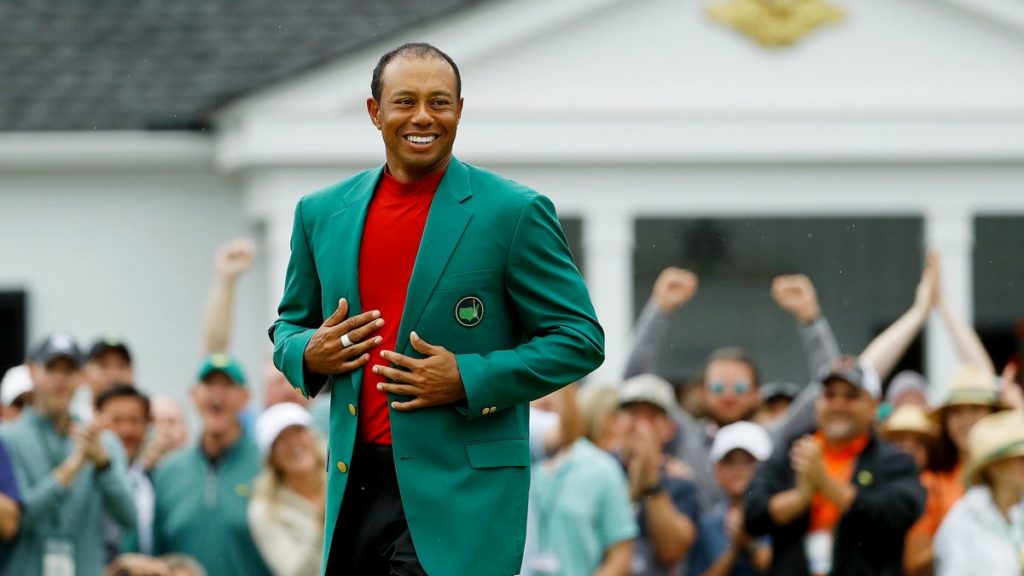
When Tiger Woods captured his 3rd US Open in June 2008 in a thrilling playoff victory over Rocco Mediate the likelihood the 32-year-old would be winning additional major championships appeared a foregone conclusion. In just over 11 years in playing professional golf Woods had won 14. Given that record setting pace -- passing the record of 18 major wins by Jack Nicklaus -- seemed a near certainty.
So much for certainty.
It took Woods just under 11 years to claim his 15th with his 5th victory at The Masters last April. A series of surgeries, infidelity scandals, and an arrest for being under the influence of alcohol and drugs pushed the world's premier sportsman off the rails.
Today is Tiger's birthday and at 44 he faces daunting odds. Winning a series of majors is still doable, however, given the track record all of the previous elite players have faced when reaching that age the odds are considerably against that happening. Even adding one additional major would be a spectacular achievement. Nonetheless, throughout his career, Woods has clearly shown the capacity to attain what others have never been able to achieve.
The majors have long been the sine qua non in determining golf royalty. When obituaries are written the key element regularly cited in the opening paragraph is the impact the player had in the sport and that standing comes solely from what transpired with one's participation in claiming golf's major events. To paraphrase Gordon Gekko from the movie Wall Street, "it's all about majors kid - the rest is conversation."
But winning majors can prove elusive even when current form suggests otherwise. With only four opportunities each year the desire to snare one of the titles brings increased public and media attention along with the related scrutiny. There's also the self-imposed demons on being able to go beyond previous comfort zones and whether frail psyches can handle what is required both physically and more importantly mentally. As quickly as major championship champagne can pop from the bottle it's just as possible for the spigot to go quickly dry -- often permanently.

Consider the plight of Arnold Palmer. The King won his fourth and final Masters in 1964 by six shots. Leaving Georgia, the 34-year-old had won seven majors, was on top of the golfing world and with a future beckoning with more such majors happening.
None did.
Although Palmer came close in a few such events in the years to follow -- his dominance was actually behind him. In winning his final Masters no one would have predicted his previous winning ways at the highest of levels would be forever in the rear view mirror. The hardest reality was for Arnie to fully comprehend that while he was King in name -- his reign on the course was over.
Fast forward to Palmer's European rival in terms of charisma -- Seve Ballesteros. The Spaniard played brilliantly in the final round of The Open Championship in 1988 finishing with a stellar 65 and claiming his 3rd title in the storied event. For the 31-year old it appeared additional majors would be part of the mixture.
Like Palmer -- Seve left Royal Lytham not only with the famed Claret Jug but once again stood at the apex as golf's best player. More majors would soon follow - right?
None did.
40 years since Seve’s first Open 📆 #TheOpen pic.twitter.com/UEJNr74NHk
— The European Tour (@EuropeanTour) July 17, 2019
Ballesteros did win other lesser tournaments but his overall total of five majors would forever remain his final tally.
One of Seve's chief rivals was Greg Norman. The Great White Shark burst onto the international stage with a top five finish in the 1981 Masters. In 1986, the Aussie did what no one had ever done previously -- have the 3rd round lead in all four of that year's major events. However, Greg's batting average was a mere .250 in winning just The Open at Turnberry.
Norman would also suffer some of the most inexplicable misfortunes through the miraculous play of others. In the final major of 1986 -- the PGA Championship at Inverness -- Bob Tway birdied the final hole out of a front bunker and with that took home the Wannamaker Trophy.
Nothing quite compares to the rich history and thrill of @TheOpen #FlashbackFriday pic.twitter.com/QsJJKiSO4t
— Greg Norman (@SharkGregNorman) July 19, 2019
Eight months later Norman appeared on the cusp in claiming his first green jacket at Augusta National but in a three-way playoff that included Ballesteros and Larry Mize -- it was Mize holing out a long greenside pitch shot that once again harpooned the Shark. Interestingly, Norman would inexplicably re-emerge at the '08 Open Championship at Royal Birkdale and have a two-shot lead going into the final round at age 53 before succumbing to winner Padraig Harrington.
Norman's stellar play during his competitive days was outstanding -- holding down a then record 331 consecutive weeks as golf's top player. But when the final tally of majors is counted -- the Sharks sports a toothless total of just a mere two.
Going into 2020 Rory McIlroy -- golf's number two ranked player -- is looking to resurrect his presence in the majors. It's hard to imagine that the Ulsterman made a sprint like effort when getting his professional career going -- claiming four majors including two in one season in 2014 by the age of 25. To top matters off -- Rory became only the 3rd player to win four majors before turning 26.
Like the other champions previously mentioned -- it appeared McIlroy was on the fast track to getting to double digit majors in a career. What's happened on the major front since that win at Vahalla?
Zero. Nada. Nil.
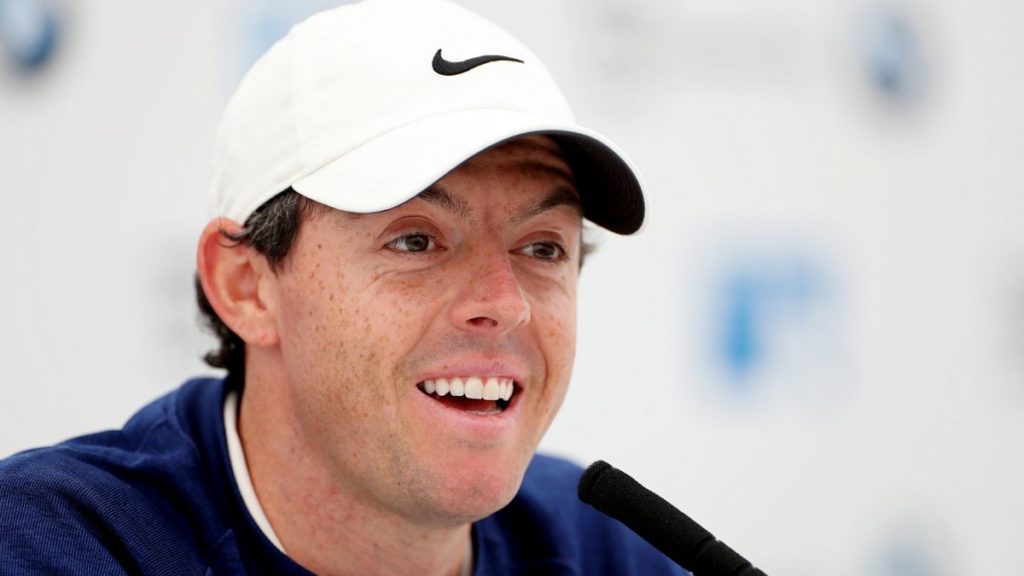
McIlroy is well aware that even with an outstanding record of consistency in 2019 -- earning him PGA Tour player-of-the-year honors -- it's crucial that now in the peak of his career to bag his 5th and doing so at The Masters would be a double bonus in having him join golf's ultimate elite fraternity -- just the 6th golfer winning a career Grand Slam.
The storybook ending Jack Nicklaus achieved in claiming his 18th and final major title at age 46 in winning his 6th Masters is the rarest of situations. But such a feat could have been bested when eight-time major winner Tom Watson nearly capped his superlative career with a triumph that would have been among the all-time achievements in any sport -- winning The Open Championship at an unheard of 59-years of age. It was not to be but the premise spouted by certain players that majors are just another tournament usually comes from the ignorant mouths of those who have never won one.
The press-created tagline, "best player to have never won a major," is the ultimate compliment wrapped around a clear insult. Good enough to merit discussion but not good enough to finally reach the promise land. One need only ask Colin Montgomerie about this sobriquet. Ditto the 31-year-old Rickie Fowler, who despite his winning personality and stacks of money from off-course commercial endeavors, is also looking to get the moniker forever off his shoulders. Fortunately, Phil Mickelson was able to shed that distinction but only doing so after reaching age 33 in winning the 2004 Masters.
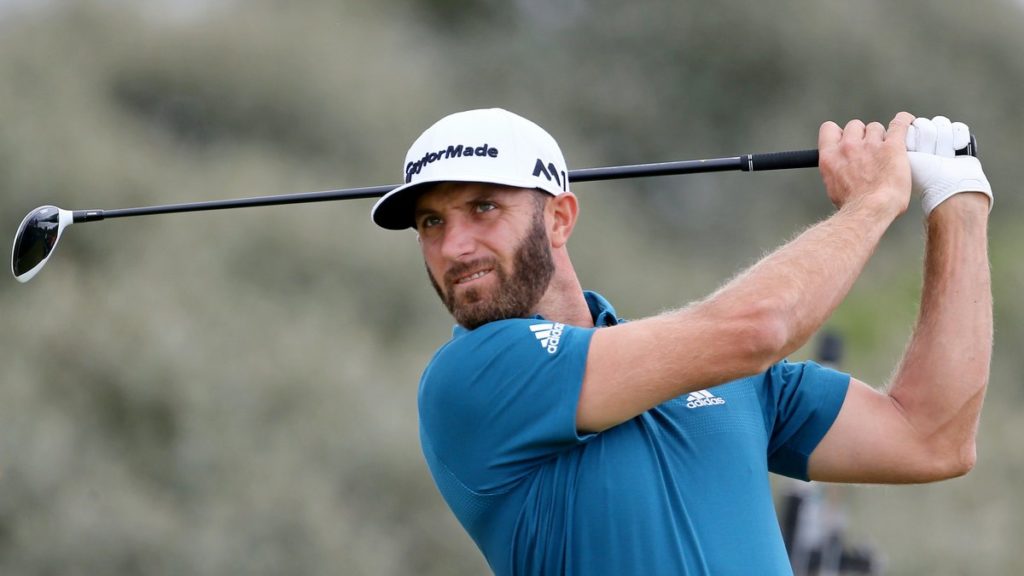
The fear that the next major may never take hold is rarely publicly acknowledged but for three-time winner Jordan Spieth the specter of having had his best days behind him as a 26-year-old is certainly not so readily dismissed since his last win anywhere came at The Open in 2017. The same can equally be said of Dustin Johnson -- a man who has won at least one PGA Tour title in his first 12 seasons -- a mark only surpassed by the likes of Woods and Nicklaus. The 35-year-old Johnson has won 20 times on the PGA Tour, attained the 5th longest reign as the game's premier player yet only has the 2016 US Open title as a major accomplishment., His inability to match his prodigious skills in the biggest of events have led many to believe he is certainly on one list -- golf's greatest underachievers.
For Brooks Koepka, the number one player in the world. and winner of four major titles since 2017, the 29-year-old is now at a point in his career where his overall standing can ascend among the all-time golf listing of players. The key is being able to maintain his sheer dominance in playing his finest when the stakes are at their highest.
As the history of the game has demonstrated -- past performance -- while certainly something of importance -- can never be presumed to be a guarantee of future outcomes.
Watching Woods comeback in returning to the pinnacle in golf with his 15th major has had many presume his chase of the Nicklaus record of 18 is now resumed in earnest. Of course, the leap from 15 to 18 does require securing numbers 16 and 17 first. But bear in mind -- no pun intended on Jack -- what happened to Palmer and Ballesteros can easily cross over to Woods. Thereby leaving the shining moment where Woods extended his two arms high into the air after holing his final putt the final scene etched in the memory banks.
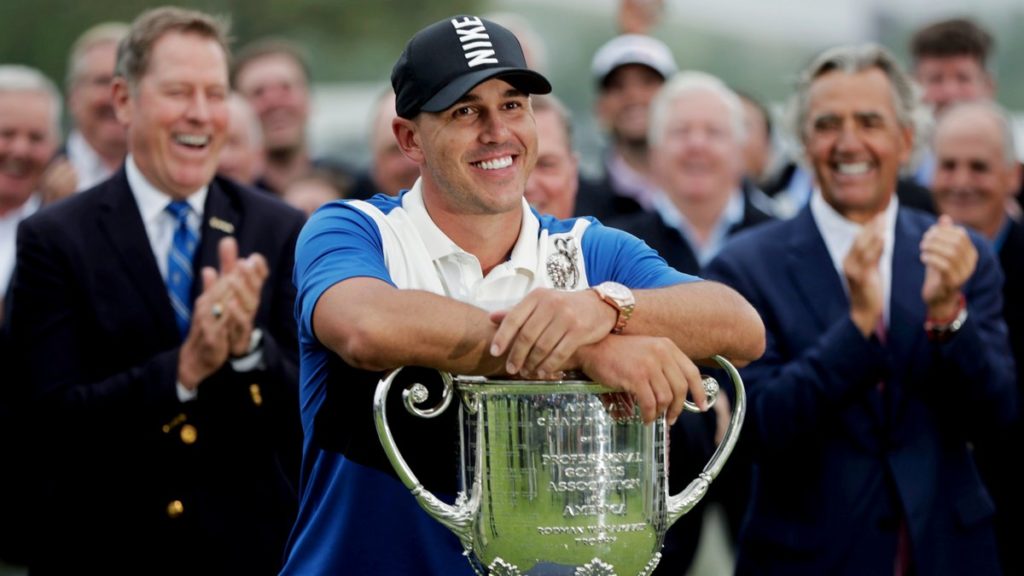
As 2019 fades into the history books -- a new year is nearly upon us. The storylines for 2020 will be most interesting to watch. Is Woods able to add to his herculean total? Can Rory add to his story? Does King Koepka remain on the throne? Greatness neither comes cheap nor easy but immortality in the pantheon of the game comes with two irrefutable points --
Continued relevance comes goes beyond resting on past laurels. Like time and tide which wait for no man -- the magic and mystery of the majors is clearly golf ultimate proving ground. Seizing the moment in 2020 for any of the top players will dictate not only their current standing in the game, but more than likely their overall placement in history.
The golf world is going through a clear reshuffling of the course deck. The shock waves from The Great Recession, which officially ended in 2009 still reverberate. Since 2011 more than 800 courses have closed in North America and that trend is now ebbing. The golf market is clearly in transition as baby boomers age out and the question on whether Millennials will take to the sport still remains unanswered.
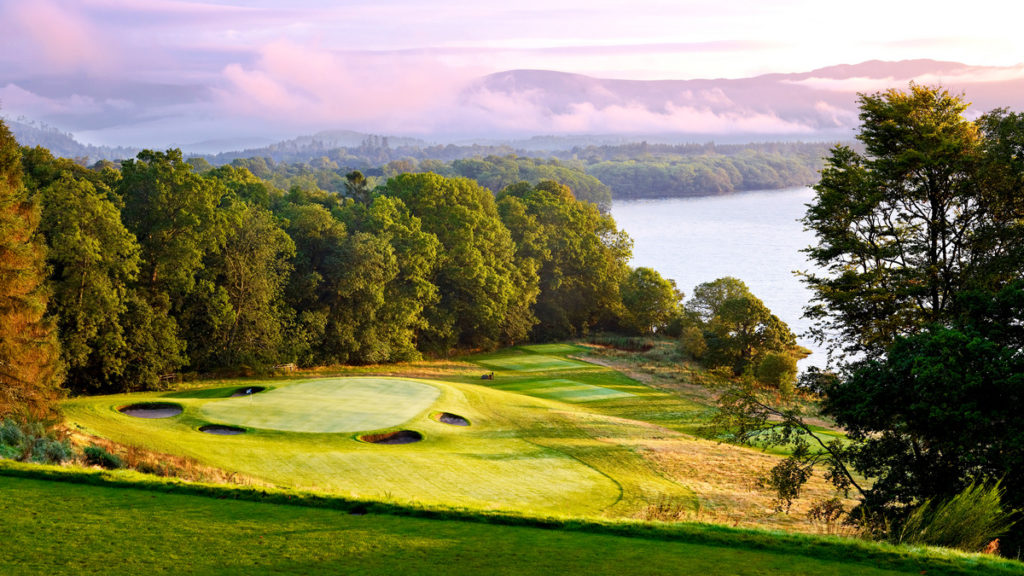
What does 2020 look like?
Four architects were asked to give their perspectives on how they view the marketplace - primarily with a North America perspective - and what key issues need to be dealt with directly and decisively.
The golf market has clearly evolved. Past assumptions have clearly been impacted by a fast moving changing landscape. The challenges facing the golf market are varied and some will not be immediately solved. The golf courses coming forward will need to deal with a myriad of challenges topics and the wherewithal to deal with them will clearly determine the economic successes of the game itself.
Four golf course architects with active golf architecture practices in North America weigh in on how they see the present market and what likely lies ahead with the new year beckoning.
MICHAEL BENKUSKY: A. We are seeing a lot of destination golf being built which is great for the core golfer. Many areas are starting to embrace the short course and nine-hole golf courses are great for the beginning golfer and the time strapped golfer. I feel we are in a good place at this time.
JAY BLASI: C+ We have a handful of developers who are committed to great golf architecture and a great golf experience. We are starting to see some municipalities "get it" and invest in fun, sustainable, high-quality design. And yet we still have many clubs or developers who seem to invest in or focus on the unsustainable elements of the game or develop golf for non-golf purposes.
BRIAN HUNTLEY: C- at this moment in North America. Very conservative and not willing to invest in anything other than a traditional 18-hole facility.
DOUG CARRICK: C- at the present time. While the industry has basically done what was required to adjust to depressed market conditions, including closing golf courses in over saturated or under performing markets, promoting more family friendly facilities and reduced membership fees or pay as you play rates. However. little has been done to address more significant problems relating to maintenance costs, land costs and reducing the footprint required for regulation or championship golf courses.
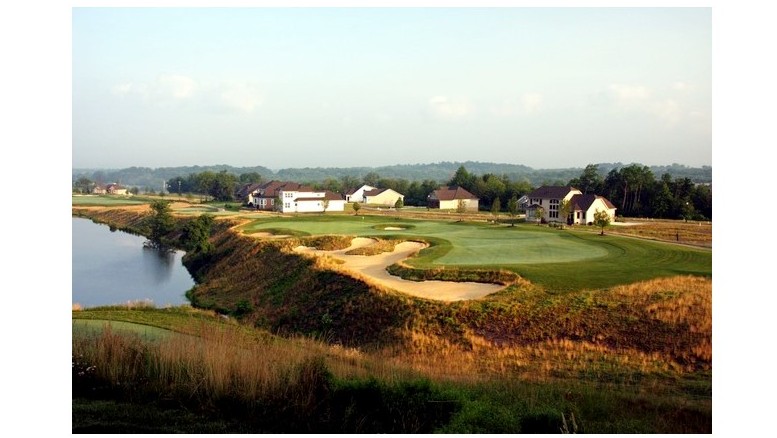
DC: The elimination of unprofitable or under-performing courses follows a natural selection process similar to the laws of the jungle -- a survival of the fittest. The rising value of real estate, in densely populated urban areas, has also placed increasing development pressure on many existing golf courses, especially those on valuable real estate with development potential.
JB: Contraction is happening. I think contraction can be a good thing if you lose poorly designed courses built for the wrong reasons and reinvest in those in good areas. Unfortunately, we are losing some good courses or courses that could be good in good locations while many poorly designed courses remain.
BH: I mainly practice in the Midwest. There has been a substantial loss of golf courses in this area. Some of this loss was the consequence of ill-conceived projects, and mismanagement. The success of a course depends on numerous factors, including course density, proper management, demand, and facilities serving the correct demographic. Just like any business, a golf course needs to identify its market and niche and make sure there is a demand for it before it is built or renovated. This basic principle needs to be followed or the course will struggle.
MB: I believe we are still seeing some weeding out of under-performing golf courses, it is just something that isn’t happening right away. Some of this is due to the current economy and owner’s hoping that it still trickles down to their course. But for this to happen they will need to invest in their course to keep up to their competition. I think to lose 20-25% would be a stretch, more like another 10-15%.
JB: There is a consumer market, but I'm not sure there's much of a developer market. The developers who are offering a high quality product are asking for, and receiving, a premium for such. I'm a strong advocate of creating a non-profit foundation that invests in high quality affordable golf. Imagine having a facility like Bandon Dunes at 1/3 the price?
DC: In a word -- yes. The challenge is finding ways to make them economically feasible. Scenic properties with great natural character combined with lower land costs, construction costs, maintenance costs and minimal debt have a much greater chance of success in providing more affordable but high quality golf experiences.
MB: We are seeing more community golf, the roots of the game, begin to take more interest in the design of the golf course. They see that to compete with their competition, they need to create interest. Finally, we are working with the Golf Course Superintendent’s Association of America (GCSAA) to create courses that can be maintained at affordable levels.
BH: I definitely think there is a market for quality and affordable architecture. In fact I believe myself and many other architects have been providing this service for years. Owners who attempt to renovate without expert input wind up with poor results and wasted money. I believe renovation design allows me to be more creative as well as focused on the big picture. I believe it is even more crucial to have an experienced, affordable architect who is willing to help a client with these more realistic budgets because every dollar matters.

BH: We in the industry understand how important and sensitive this issue is. I think we are all trying to educate the masses, including golfers, how this industry cares and strives to be as efficient as possible. Perhaps we are to blame for failing to fully educate the general public on all the new technology, and the measures most courses take to save water and the benefits that golf courses provide to local wildlife, micro climates, recreation and economy.
DC: Key stakeholders have been well aware of the concerns related to water usage for many years. In general the industry has responded positively. More can be done to educate golfers that drier, firmer and faster running golf courses can be more fun to play than those lush and green, by adding a greater dimension to the ground contours and their effect on course strategy and play.
MB: We have seen the importance of water drive many projects. The inclusion of more drought resistant grasses and the installation on pin-point irrigation systems golf courses are beginning to cut back on water use.
JB: I think most golf architects, superintendents, GM's, etc, understand the water issue and advocate for appropriate steps to be taken. However, ultimately it is the owner that decides and many owners or clubs prefer green grass over sustainability. Hopefully events like The Presidents Cup at Royal Melbourne will help.
MB: I think the USGA, R&A and PGA of America doing good things to create interest and are helping architects with many of their studies on grow the game initiatives. We are working with them to aid in their research and are beginning to incorporate their research in our designs. The biggest impact the PGA and LPGA Tours are bringing to the game is the new generation of golfers that are leading their Tours and they connect with these groups We still see the Tiger effect which, if he continues to play like he is, will continue to drive interest in the game.
DC: The USGA, R&A and PGA of America have made efforts over the past decade to try and grow interest in the game among Millennials, women and minorities with initiatives like the First Tee Program, Get Golf Ready, the Drive, Chip and Putt Competitions and other outreach programs. However some efforts have felt somewhat desperate a times, with suggestions using like larger holes, foot golf or trying to make the game more appealing. There's nothing wrong with the inherent premise of the game. The golf industry has to stop trying to fix the game and address real issues affecting participation, cost and time constraints.
JB: I think they each make an effort but it isn't their sole purpose or even primary focus. I would love to see each of those groups come together to create a non-profit foundation that would invest in affordable high-quality public golf. Things like offering free clubs to anyone under 18 at every municipal facility in the country seems feasible to me if these groups and club manufacturers supported such.
BH: I believe they are making very concerted efforts. We all could do more. I believe the media could help because there is more to golf than the PGA tour. It seems to me they cover the same people, all the big events. But there are so many other stories about interesting affordable courses that the average golfer can actually play. The majority of golfers play public facilities and articles on these affordable and interesting facilities may help persuade people that golf is not an elitist sport and actually can be welcoming and fun.
JB: I would love to work outside the US. My wife is from Germany so doing work in Europe would be exciting. I'd also love to work in Australia and New Zealand. Hopefully those opportunities will come in the near future, but it isn't a necessity.
BH: No, I focus on regional work and renovation work. I also try to promote and develop 9 hole or short courses whenever possible on smaller properties.
MB: Luckily, my work has been steady enough that I have not had to look for work outside of North America. I still see many courses looking to make upgrades and they sometimes spread the work out over many years.
DC: We are currently involved in one comprehensive golf course remodeling project in Austria. We've also spoken with prospective clients about potential new golf course projects overseas, but none coming to fruition yet. The majority of our work remains in North America.

DC: Finding ways to make the game and golf courses more economically, environmentally and socially sustainable. Efforts must be made by all the stakeholders in golf including, golf course developers / owners, golf course architects, governing bodies of golf, equipment manufacturers, golf professionals, golf course superintendents etc. to reduce the footprint of regulation and championship golf courses.
The game cannot grow or survive if such footprints continue to expand. Rising land costs, increased maintenance costs, greater consumption of natural resources, including water, will become a major impediment to the growth and sustainability of the game.
MB: The shortage of labor. We are already seeing the effects of golf courses having a tough time finding labor and having to incorporate that into our designs. Most of this revolves around reducing maintained turf areas and reducing the amount of sand bunkers on the golf course. Therefore, reducing the time to maintain these areas.
BH: Convincing owners that we can design interesting high quality golf courses on bland topography, (St. Andrews) and that these facilities can be successful for the owners and fun and affordable to the public.
JB: Sustainability. The amount of land needed for golf given the current technology makes golf unsustainable in many cases. Courses cost too much to build, too much to maintain, use too much water, take too long to play and then they need to charge too much to survive. We could learn a lot from the Scots and Aussies.
Doug Carrick
Carrick Design, Inc.
North York, Ontario, Canada
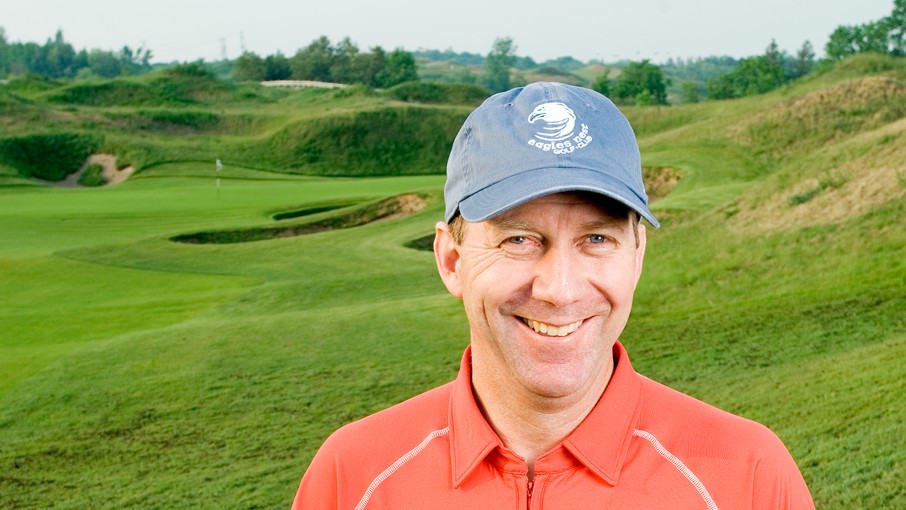
Founded Carrick Design in 1985 and since that time has designed and remodeled more than 90 golf courses throughout Canada and in Austria, Hungary, South Korea and Scotland. Past President of the ASGCA and member of the Ontario Golf Hall of Fame.
Brian Huntley
President Golf Sense, Inc.
Uniontown, Ohio
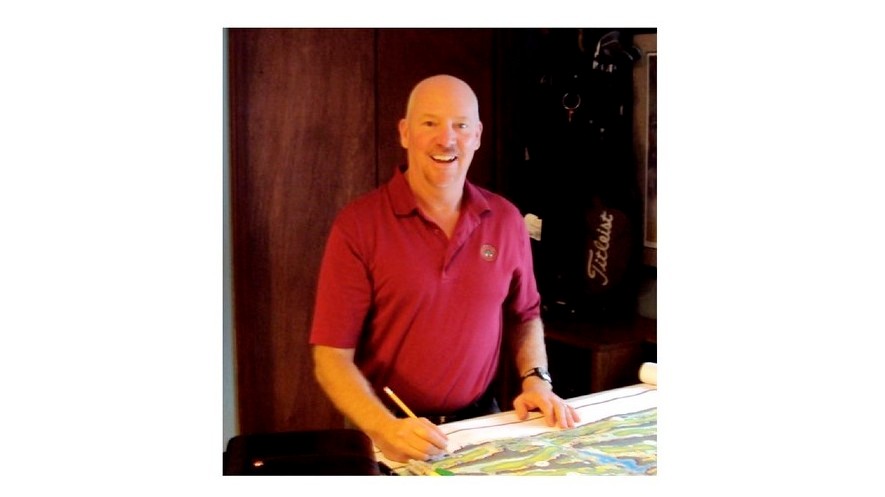
Degree in Landscape Architecture from Ohio State University, Then worked with Arthur Hills & Ass for seven years before forming his golf course architecture firm 25 years ago. Has designed over 30 golf courses and worked on over 75 Master Plans or Renovation Projects. His philosophy is to use a common sense approach, strategic design, and enhance the natural beauty to each site.
Jay Blasi
Owner, Jay Blasi Design
Los Gatos, California
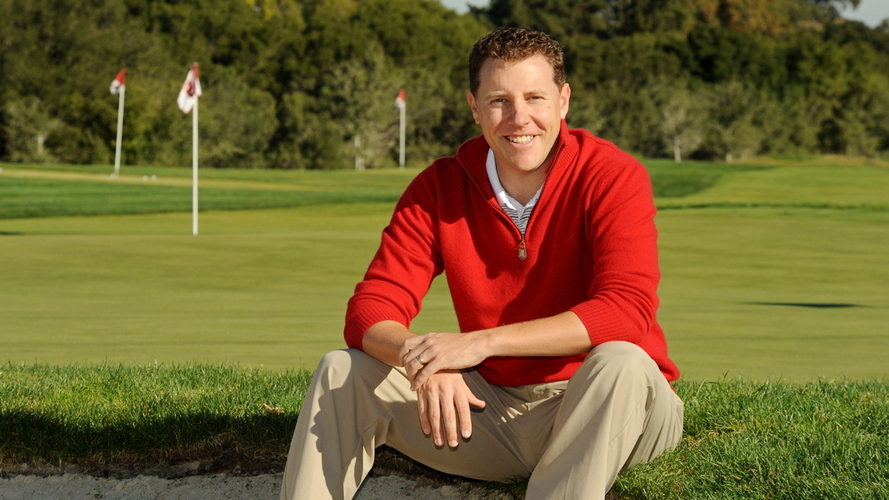
Grew up drawing golf holes as a four-year-old and by high school had the dream of designing a US Open course. Spent 11 yrs working with Robert Trent Jones II, LLC and served as project architect for Chambers Bay, site of the 2015 US Open. In 2012, started Jay Blasi Design and since then has led award winning renovations of SentryWorld and Santa Ana CC.
Michael J. Benkusky
President, Golf Course Architecture
Lake in The Hills, Illinois

A full-service golf course architecture firm that specializes in new golf course design, existing course remodeling, and classic golf course renovation. Our vision is to create, preserve, and enhance golf courses and their environments.
We’re all well aware of the importance of putting – but how often do you really put in some serious effort on the practice green? Let me give you a strategy covering four key perspectives: technical, tactical, practical and co-ordination. Whatever your standard of golf, I’m certain that one or more of the drills within each of these sections will inspire you to better putting figures and consistently lower scores next season
Dan Frost
Confused about how the grip of the putter should run through the hands? Let me kick off with a simple way of finding a good hold, running the grip correctly through the lifeline of your hands. This will help you to create the correct relationship between the hands, wrists and posture in a simple manner.
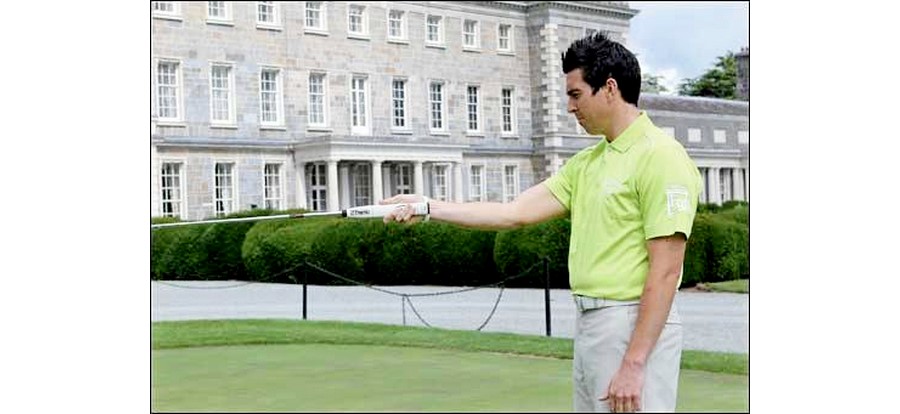
Step 1: Secure the grip into your top hand as you would if asked to aim the putter as if you were pointing a pistol in front of you.
Step 2: Find a good relationship with your low hand. (I say high and low because as you can see I predominantly prefer the left-below-right grip, whereas for you it may be the other way round.) You should now get the sensation that the club is sitting in the lifelines of the hands, the top of the wrist bone is slightly inverted and there is a line forming between the club shaft and the forearms.
Step 3: Now simply keep this relationship and slowly tilt forward from the hips until the sole of the putter touches the surface of the green.
Step 4: All you need to do now is find nice balance through your feet with the weight nicely in the middle and knees slightly flexed. Notice how I have kept the relationship formed from my hold through my forearms.

‘Rock your shoulders’ is a phrase that most of us have heard on the putting green and yet very few club golfers actually achieve a pure shoulder-controlled pendulum stroke.
The problem, of course, is that it’s all too easy (and instinctive!) to want to use the hands and wrists – after all, you are holding the putter in your hands and fingers. But for control and consistency we must start higher up. The key to creating this superior pendulum motion lies in adjusting your focus, so that you feel the momentum of your stroke originating from the shoulders. Here’s a drill that can help you:

Step 1: To isolate the movement of the shoulders trap a cane between your upper arms and the top of your chest, allowing your arms and hands to hang down towards the green
Step 2: Next, form your regular grip trying not to add too much tension to the hang of your arms
Step 3: Comfortable in your starting position, initiate motion by making the cane work up on the backswing and down in the throughswing.
Step 4: Make sure you hold your finish to show control and to familiarise yourself with the feeling that the hands have been relatively inactive.
Maintaining the symmetry of the relationship between your left shoulder, arm and puttershaft is one of the easiest ways to transform the consistency of your stroke. Most club golfers tend to break down their wrists through impact in an attempt to re-direct an already failing stroke. To build a solid action, try this drill:

Step 1: Take an alignment stick and place it up the inside of your left forearm to just above your elbow.
Step 2: Hold the stick in place by applying your right hand in a grip like formation. Same again, if you are orthodox in your grip (i.e. right hand below left) feel free to do this in the same style.
Step 3: All you need to do now is rotate your shoulders whilst keeping the cane touching the inside of your left forearm as you rehearse your stroke.
Step 4: Once you have a good feeling of control over the cane, introduce your putter alongside so that the putter pushes the cane against the arm.
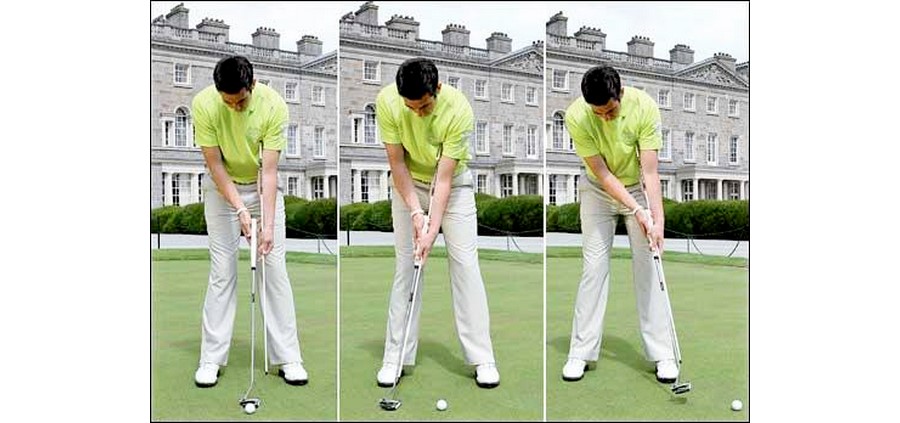
One of the most neglected fundamentals in putting is making sure your eyeline is parallel with the roll line (some players like to have their eyes directly over the ball, others slightly inside – up to you to find your preference). It is hard to appreciate the necessity of getting this position right unless you try this drill. If you position your eyes correctly you will have no problem relating to the target line and visualising each putt.

Step 1: Place a cane in your finger tips and allow your arms to hang down from a balance posture position so that the cane is pointing along the intended roll line.
Step 2: Position your eyes so that with a simple tilt of the head it is easy to look straight down the intended line.
Step 3: Replicate the same feeling with the putter in your hands. You should get a good sensation for alignment and your eyes being right over the top of the ball.
As a junior I used to love going to tour events at Wentworth and watching the great stars working on their games. I can particularly remember watching Nick Faldo on the practice putting green and being struck by just how ‘solid’ he appeared over the ball, his knees separated and the left side pushed slightly outward towards the target. This gave him the perfect platform for consistency. The following drill will allow you to feel and enjoy the same solidity in your putting posture:

Step 1: Push a cane into the green so that your left knee and hip are pressing softly against it.
Step 2: Maintaining this pressure onto the cane from your left side, rock your shoulders and focus on keeping the lower half stable.
Step 3: Hold your finish for three to four seconds so that you can appreciate your newly-gained stability.
Once you have read the line and visualised the ball running all the way into the cup, the secret to turning these images into reality lies in developing a routine that almost runs on auto pilot. What you don’t want to do is return to the ball and then spend an eternity standing over a putt, repeatedly looking up to remind yourself of the line. Much better to see it, set up to it, and then hit it. Australian Aaron Baddeley is a terrific example of a player who exhibits this discipline on the greens – and it’s worth following his example.
I question a lot of amateurs on the subject of visualisation. Standing over a putt, what do they ‘see’? Most answers fit into two categories: either (1) they are just concentrating on the hole, or (2) they are looking for where the ball should break from.

Neither of these responses comes close to resembling what you should see over a putt. If you want to raise your standard you have to see the whole journey to the hole. The photos here illustrate the image a pro has in mind – a trail all the way into the middle of the cup. To be a better putter, add some detail, see the entire journey and believe you can hole every putt.
‘Flow’ is such a great word for golf. It encourages natural movement, instinct and rhythm. Another word we don’t use very often is ‘rehearsal’. I hear a lot of coaches telling their pupils to ‘make a practice swing’ but very few ever suggest rehearsing what they hope to replicate for real.
That’s the crux of this drill: rather than making a couple of half-hearted practice strokes that have no relationship to the intended task, use your imagination and build a rehearsal flow routine by rolling two imaginary putts before your real one.
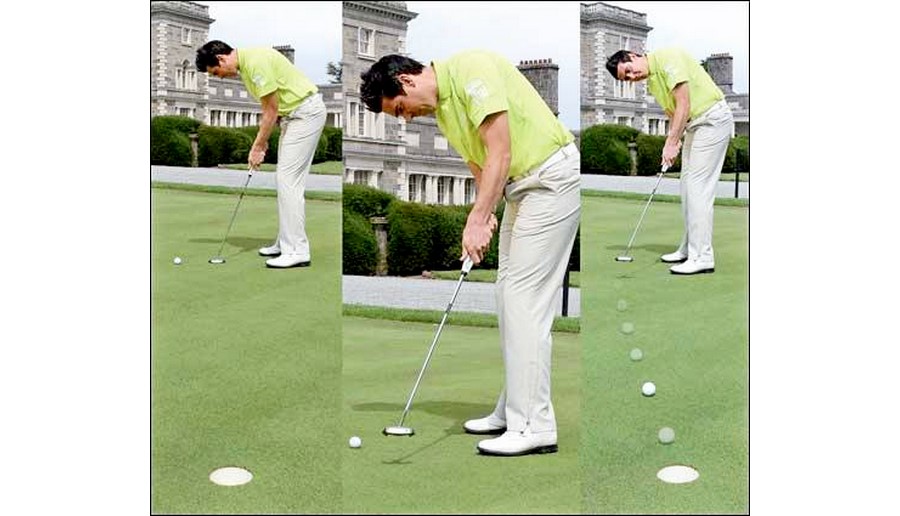
Try to do this in one continuous motion, so that you make the two rehearsal strokes back-to-back, all the while with that visualisation in your mind’s eye. Then simple make your actual stroke the third putt in the sequence, repeating the rhythm and flow of the two rehearsals
Why is it that certain shape putts seem really easy and others we tend to struggle with? The answer is simple: our subconscious retains memories and forms a default setting/tendency. When working with golfers I soon get a feel that they ‘will’ or ‘won’t’ make certain putts. Not because of the difficulty, but because of their belief and previous evidence of them making a stroke and missing putts. How do you change this default setting?
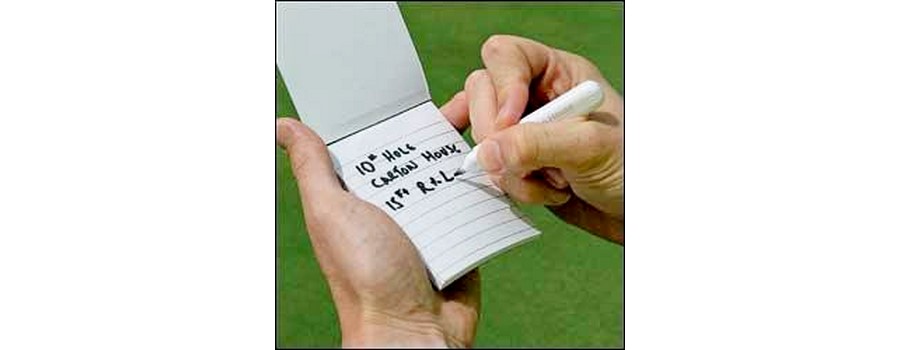
You can make a start by recreating moments from your round and working on specific putts on the practice green. Here, for instance, I’ve made a note of a poor putt that I made on the 10th hole – a 15-foot right-to-left putt that I didn’t commit to striking properly. A simple entry in a note pad provides you with a specific focus later on the practice green. To turn this negative memory into a future positive, all you have to do is follow your process and go to work on rolling the ball in. Hit putt after putt until you are comfortable.
Carrying a note-pad and using it to record highs and lows of your round (in all areas of the game) will gradually reveal the areas which most need your attention allowing you to tailor your practice time accordingly.
Chances are you have limited practice time, so it makes sense that you focus your attention on putts from 10 foot and in. Why? Because these are the putts that make the most difference to your scorecard. Think about it this way: if you hit a green in regulation your first putt would always finish inside 10 foot (even a bad one!) If you miss a green, 90% of the time you are going to recover to within 10 feet of the hole. And on those occasions when you do set up a great birdie chance… it’s usually 10 feet and in.

No surprise, then, that the pros spend more time grinding their technique from this range than anything else. And there’s an easy way to create a consistent challenge. The average putter is about 36” long and thus makes for a great measuring tool. Simply lay it on the green and use it to measure out three-, six- and nine-foot putts. Start on a flat area of the green and then spice things up with some sloping putts, each time working your way continuously holing from short-to-long. This will create great confidence in an area of the game that really is critical to the bottom line.
Finally, here are some interesting statistics from the PGA Tour 2011 – food for thought as you measure your skills against the best players in the world.
Let me leave you with a few out-of-left-field drills that can seriously help to sharpen up your levels of balance, rhythm, instinct and general coordination – none of which will do you any harm at all when it comes to rolling a ball into the hole. Go out and test yourself – if you can master all five, then holing putts out on the course will feel easy.

WEDGE PUTT: Practice rolling putts with the leading edge of your wedge. This takes precision and concentration.
ONE-HAND ONLY: Alternate rolling putts one-handed, switch between right and left hand with the opposite hand across your chest. This will improve feel and control.
TEE UP PRECISION: Place three balls on varying heights of tee peg. Attempt to roll the ball without moving the tee. Again this will improve strike precision and focus.

EYES SHUT: Striking putts with your eyes shut will improve your sense of feel and trust in your stroke.
ON ONE FOOT: Try rolling a few putts standing on one foot your other foot raised behind you. This will improve your balance and teach you to control your core.
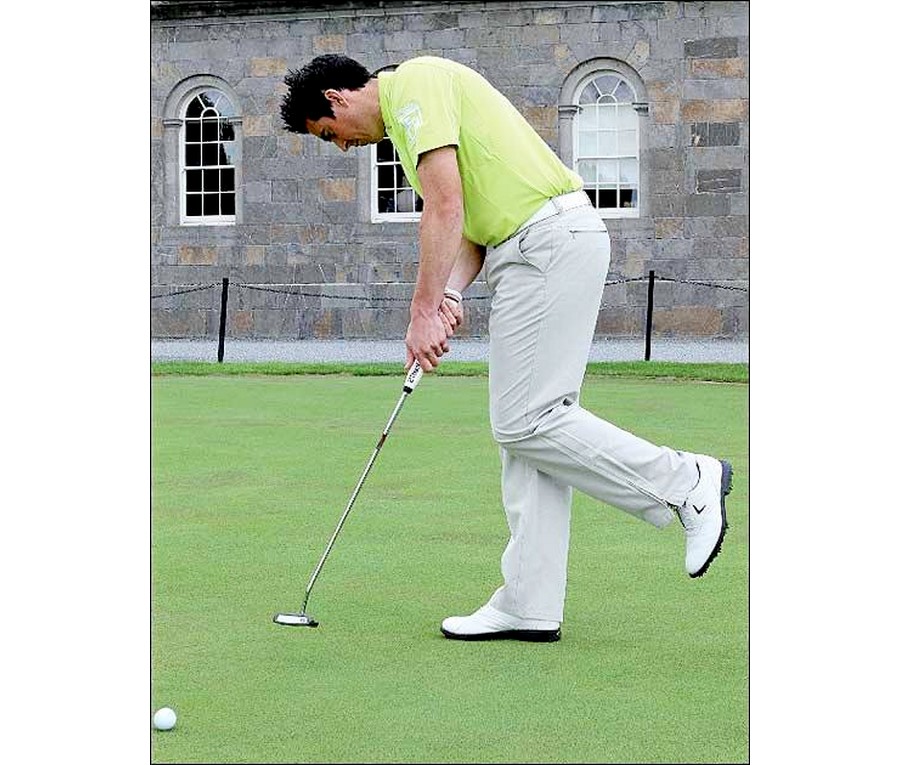
Whatever your current level of play, saving shots in the short game is the quickest route to shooting consistently lower scores. And in terms of learning new skills, it’s also the easiest. So let me share with you some of the thoughts that I believe you need to learn to develop a basic pitching technique – one that will reward you with the ability to influence the trajectory of the ball and thus expand your repertoire with a wide variety of shots
By Pete Cowen
From a practical point of view, the theme to the lessons I am about to share with you here is that the role of the upper body is vital in the process of creating a repeating method.
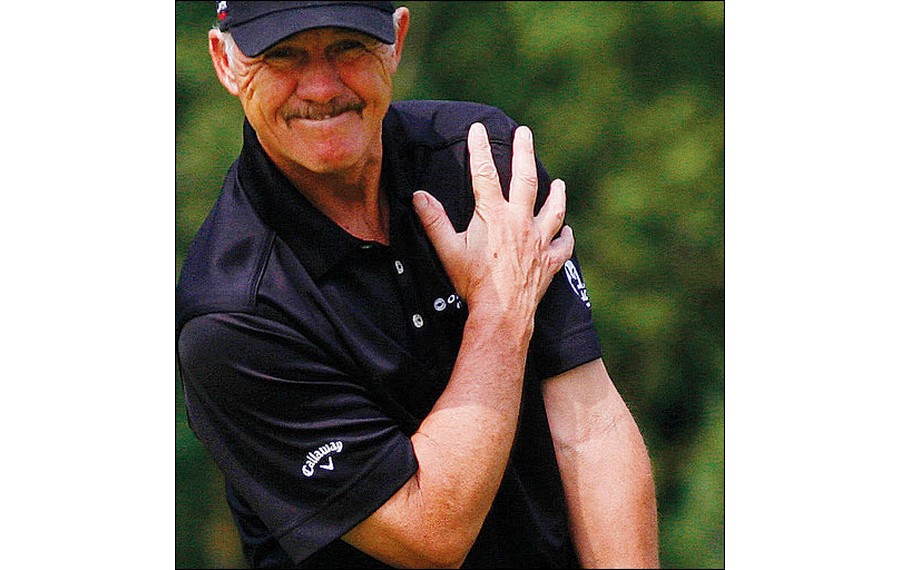
The cardinal error is to rely too much on hand action (as per the insets below you see here showing two of the most common faults in this department of the game). Watch good chippers and pitchers of the ball and you will see that the momentum of their action is controlled by the turning motion of the upper body – that is the secret to the consistent behaviour of the arms, hands and – ultimately – the club. And as the upper body keeps on turning, so the left shoulder works up and around to the finish. For me, that’s key.
So, let’s get to work and look first at a simple drill that will set you on the way to experiencing the sensation of a bodycontrolled pitching technique. The rewards will be worth it, believe me.
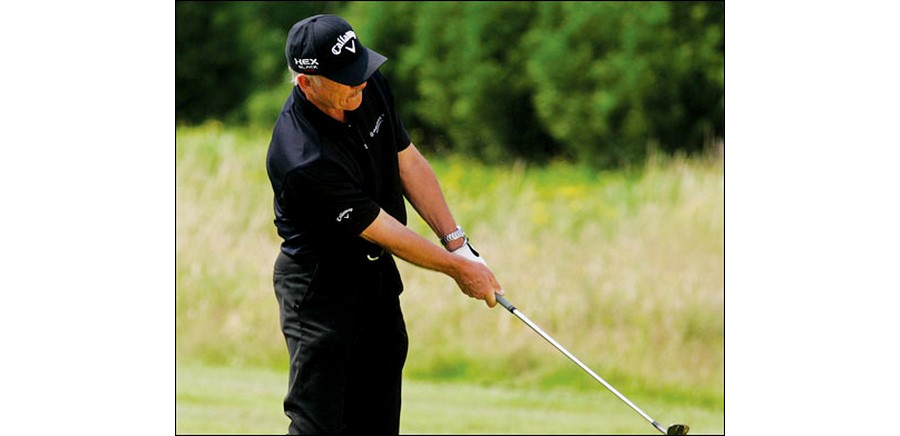
Poor chippers and pitchers of the ball tend to rely too much on their hand action through the hitting area. They fail to grasp the vital sequence of motion – i.e. the controlling influence of the body – and over-use the hands. Higher handicap golfers are prone to flicking at the ball with a wristy motion (below left), while in the case of the better player you often see the hands driving forward through impact, delofting the clubface (right). Both of these faults create imbalance in the swing, and kill any versatility around the green.
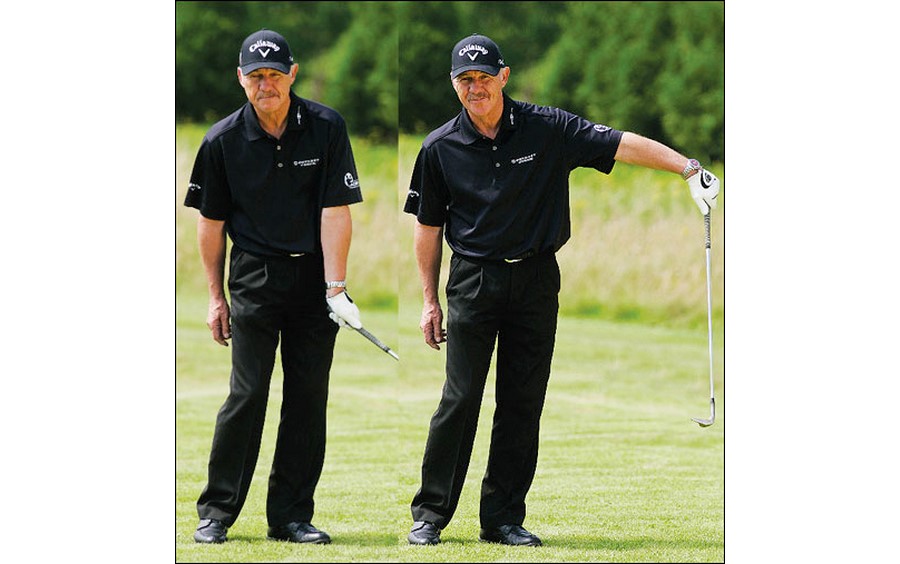
Whenever I get asked for the ‘secret’ to a good pitching action, I point golfers in the direction of this wonderfully effective exercise – one that quickly rewards you with the sensation of upper body control that is vital to enjoying a consistent strike in this all-important aspect of the game.
To start, simply get yourself into a comfortable set-up, your feet fairly close together, left toe turned out slightly, and weight just favouring your left side. Then take your right hand off the grip and place it on your left shoulder. In so doing, you are immediately be made aware of a heightened sensation of left side control. Your left hand has a comfortable (i.e. not too tight) hold on the grip, while placing your right hand on the left shoulder simply raises your awareness of that area of the upper body.
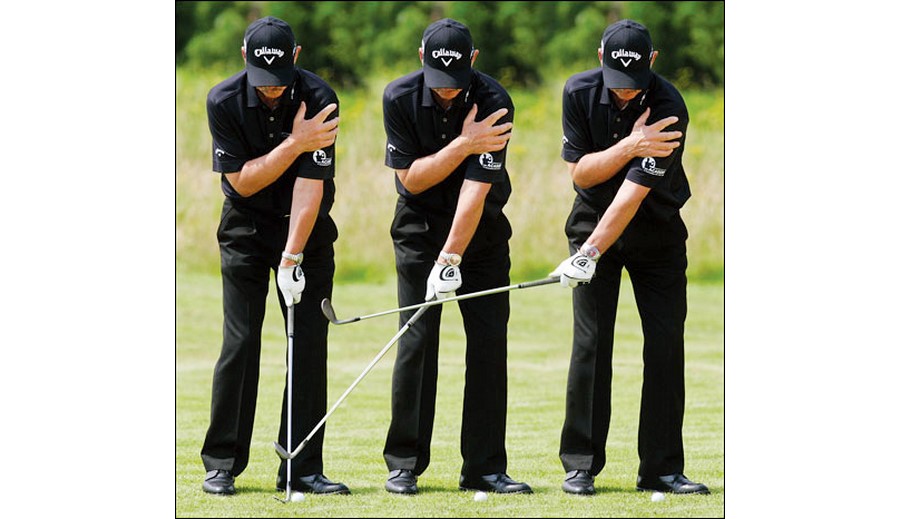
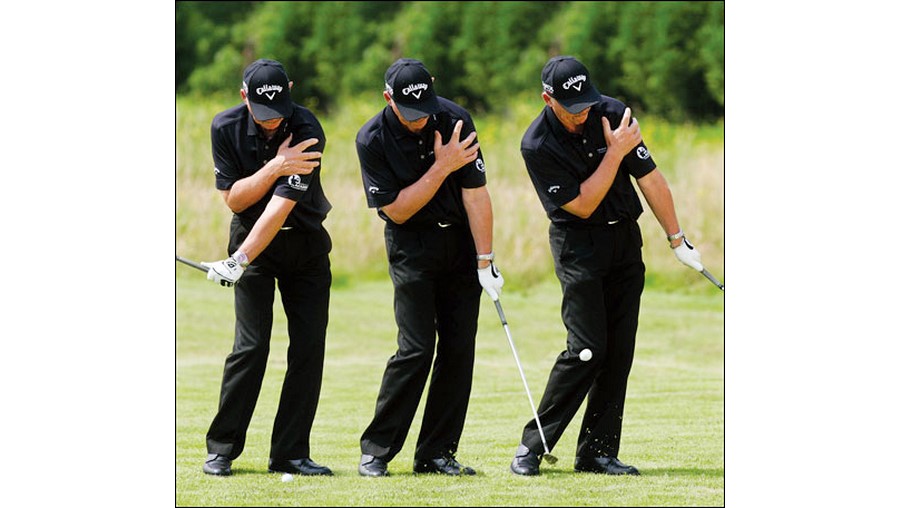
Now go ahead and make a simple swing, your focus being on controlling the motion with the turning of the left shoulder – you want to feel that your right hand pulls the left shoulder down and around into the backswing, setting off a chain reaction as the arm and hand respond, the left wrist cocking gently in response to the weight of the clubhead.
The real beauty of this exercise is felt on the way back down to the ball and through impact. With your right hand now encouraging the (re-) rotation of the left shoulder, you want to feel your upper body paces the return journey, your left arm/hand following this momentum, the left wrist uncocking naturally and the clubhead collecting the ball in the process. There is no manipulation whatsoever in the strike. It is neutral as the left arm and body work in unison. As it was at the set-up, the shaft is seen to be leaning toward the target at impact, but – most important of all – it is working up on its way to the finish.
Supported by a subtle knee and leg action, the upper body is turning through and left (of the target line), clearing the way for the uninhibited strike on the ball and the release to a controlled finish.
Regular repetition of this exercise will transform your feeling for a sound chipping action and help to establish a real understanding of the controlling role of the upper body. All positive so far.
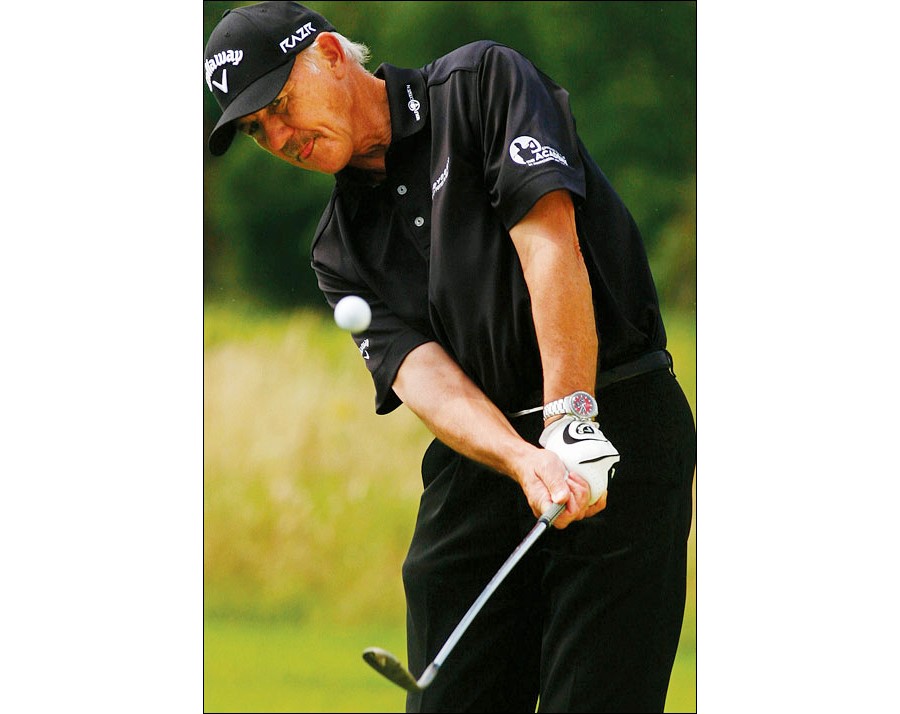
As your confidence grows in the pitching arena so you can build on the basics of good technique and extend your repertoire of shots. And the single most important lesson here is that your set-up must always reflect what you intend to do with the ball.
When you need a lower, running type of shot (sequence above), you move the ball back a fraction, lean the clubshaft gently toward the target (delofting the face a fraction as your hands ease ahead of the ball) and build your stance accordingly. The swing follows on logically from there, your weight just favouring the left side throughout, and the low shot is always characterised by a fairly low finish.
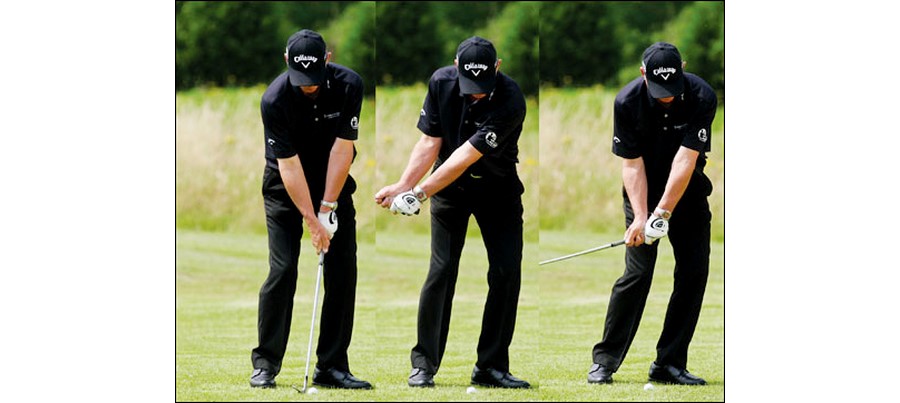
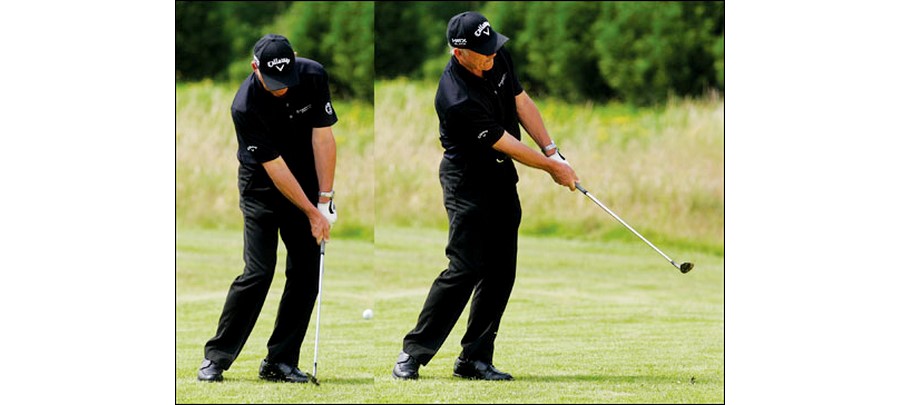
Need to maximise loft? The adjustments are as you would expect: play the ball a little further forward in the stance, lean the shaft away from the target a little, and let your body take its order from the position of the clubface as you then settle into the shot. A higher, floating shot requires more clubhead speed, so you need to extend the length of your swing and this naturally results in a fuller finish as you release the speed to a finish.
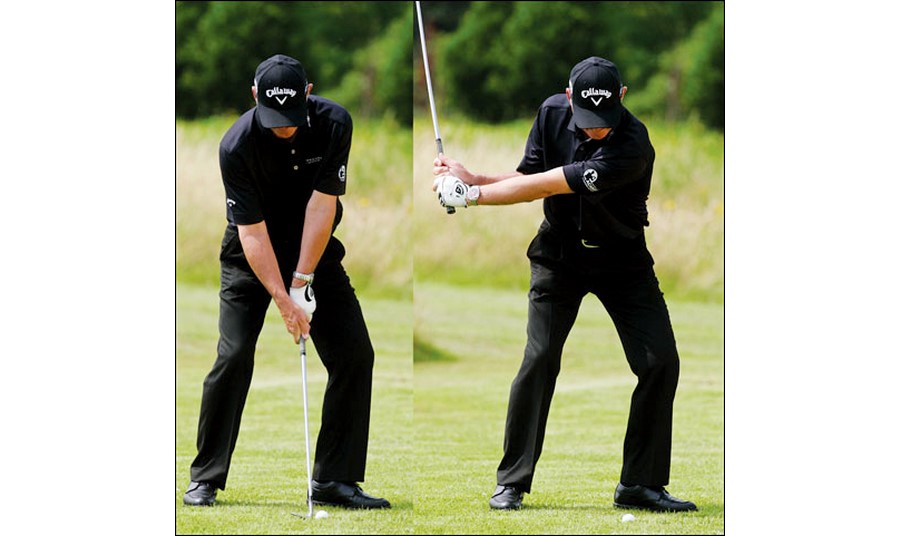
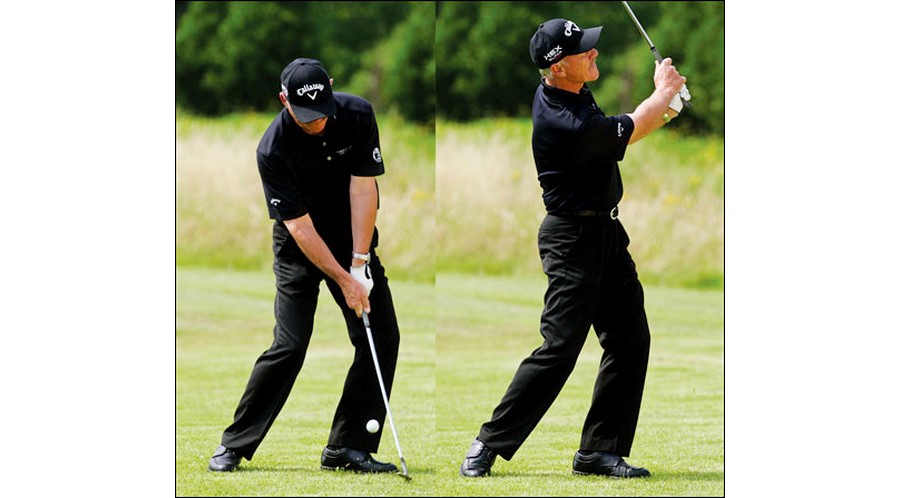
Great exponents of the short game like to ‘set’ and then maintain the angle between their right hand and the shaft. Bear that in mind as you go to work on these skills. Control the flight of the ball with the set up position, the length of your swing and the way you visualise the shot, which gives your body the message.

Splitting your hands apart on the grip, as you see illustrated here, is a great way to appreciate the sensation of the hands/wrists working and hingeing correctly in order to maintain loft on the clubface in the short game. I’d recommend you spending a couple of minutes during each practice session rehearsing this, even hitting balls with this grip, as it will quickly teach you to recognise the feeling of a good hand and wrist action. The better you get at ‘cranking’ the wrists in the backswing, the more loft you will return to the ball through impact (and that same wrist action will improve your ball striking in the long game, too)
With the emphasis again on the quality of your body rotation, I want to leave you with a couple of simple ideas that will help you to govern the pace and rhythm of your swing and, with it, finetune distance control.
The blended backswing and through-swing positions you see above illustrate the method used by the majority of tour players when it comes to controlling distance in the pitching arena; a ‘clockface’ principle that involves matching body rotation and length of arm swing on either side of the ball to identify with your ‘best’ (i.e. most consistent) landing distances using the lofted scoring clubs.
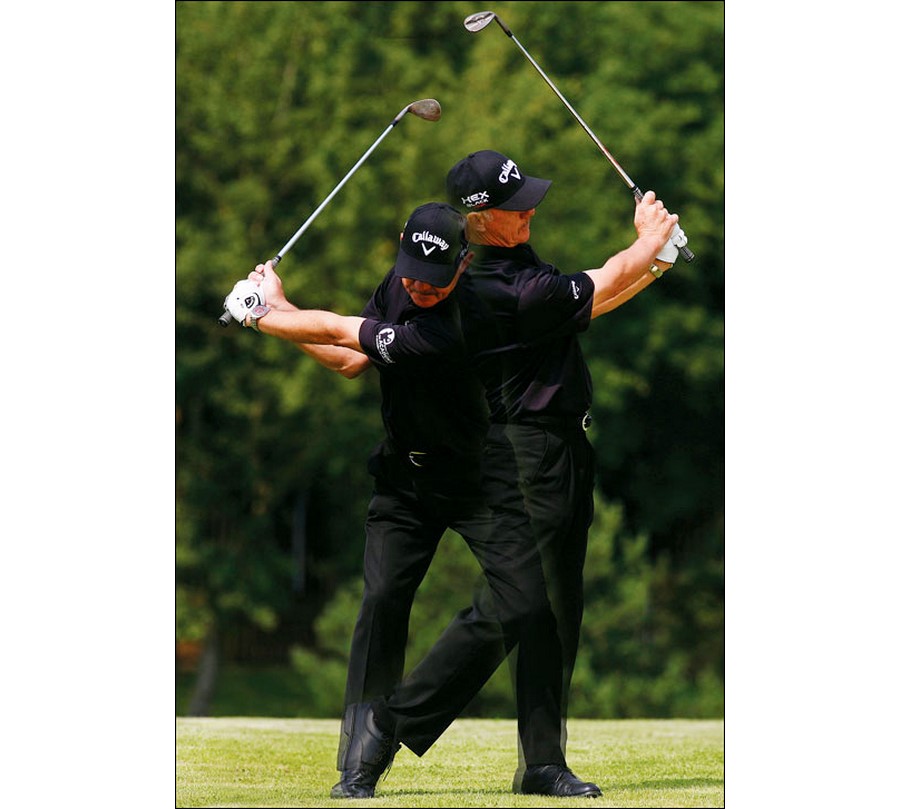
Once you grasp the concept it’s all about investing the hours out on the range to hone your feel and establish exact landing distances with your favourite wedges. So, for example, a 9 o’clock to 3 o’clock ‘half’ swing (above left) sees the rotation of the upper body take the arms and hands to approximately 9 on the clockface in the backswing, through to a little after 3 on the way through. That’s a controlled half swing – perfect in the wedge game. Hit balls with all of your scoring clubs – PW, Gap and Sand Wedge – and find out exactly how far you land the ball repeating this controlled swing.
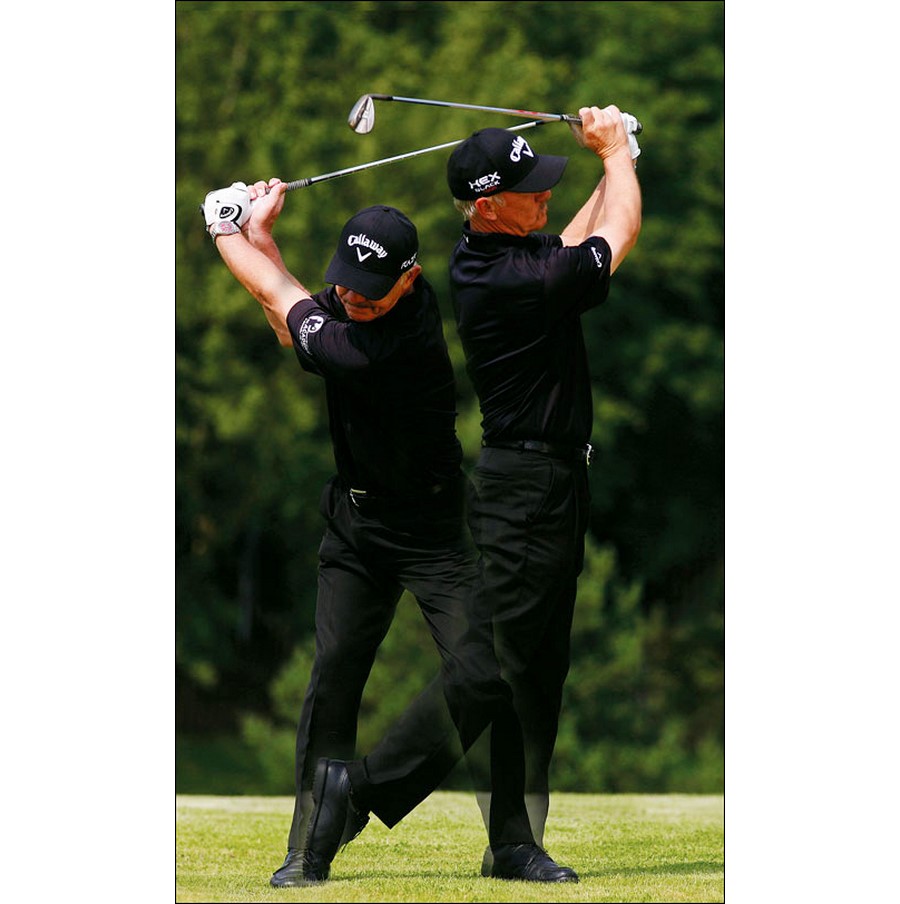
Then take it a stage further, adding a beat to your rhythm to extend your swing to what is essentially a full swing with a wedge – 11 o’clock to 1 o’clock (above right). The shoulders turn that little bit further, the arms swing that little bit fuller. Again, meaasure your landing distances – that’s vital information.

December 19-22
RACV Royal Pines Resort, Gold Coast, Queensland, Australia
AUD$1,500,000
Round 1, Round 2, Round 3
Adam Scott ended a three and a half year wait for his 11th European Tour title, winning the Australian PGA Championship for the second time RACV Royal Pines Resort.

“I'm pretty stoked, actually. I grinded it out this week and I feel like I outsmarted the golf course a little bit, which feels good, and it was good enough to beat everyone.
“It's been a long time between drinks for me and maybe only once or twice did the thought cross my mind that I'll never win again. It feels very good to win here, especially to finish the year off kind of winning at home.
“I've seen what it's done for me in the past; a win. You feel like you're just never going to lose again, so you want to run with that while the confidence is up. Somehow I'll have to think that in seven weeks when I step back in L.A.
HE'S DONE IT! 🏆@AdamScott wins the #AUSPGA and his first title on home soil in 2,266 days 🇦🇺 pic.twitter.com/CFproFgTqG
— The European Tour (@EuropeanTour) December 22, 2019
"I think it's very difficult to win. I'm on the wrong side of this age thing now where these young guys are really good and I played some pretty good golf a couple weeks this year and fell short. You know, record‑setting scores. I think the courses are getting tougher, guys are playing good. Just being alright doesn't really get you in, you've got to be pretty much sensational."
The 2013 Masters Tournament champion, who won this event that same year, started the final round one stroke ahead of a condensed chasing pack but trailed as he made the turn while New Zealander Michael Hendry made a charge.
Hendry, who was battling through a rib injury sustained earlier in the week, birdied four holes on the front nine and took the lead with his fifth gain on the tenth, but, after his sixth birdie of the day on the 16 th , he dropped to 11 under par after bogeys on the 17th and 18th holes.
“The warm-up was terrible. I honestly thought I wasn't going to get through the round. So quite honestly, my goal today was just get through 18 holes and finish the event regardless of what the score was. Lo and behold, I hit it really well.
Adam Scott analysing Adam Scott.
— The European Tour (@EuropeanTour) December 22, 2019
Sound up 👂🏼 pic.twitter.com/0f3TOKzeWU
“It was painful all day and I just kept trying to basically man up and hit the shot. Maybe that was the thing that I needed to take my attention away from what was happening on the golf course. It was more about trying to make good swings under a little bit of pain, and I made a lot of good swings.
“I'm pretty happy with the way I played considering physically what was going on. It's a shame that I didn't end up winning, but when you're not 100 percent and you're trying to chase down one of the best players in the world, you're up against it.”
It wasn't until Scott rolled in a clinical eagle putt on the par five 15 th – his third of the week on that hole – that he moved ahead once again. The 39-year-old then held on to sign for a three under par round of 69, and a 13 under par total, to finish two strokes ahead of Hendry, winning his first title since the 2016 WGC-Cadillac Championship.
"That's your shot of the day there."
— The European Tour (@EuropeanTour) December 22, 2019
Courtesy of Michael Hendry 🙌#AUSPGA pic.twitter.com/Nrn1muhqqd
Four Australians, Cameron Davis, Nick Flanagan, Min Woo Lee and Wade Ormsby, shared third place with Carl Yuan of China on ten under par.
“It was a scrappy start, I bogeyed the first two par threes, which wasn't the best," said Lee. "But I was proud of how I handled myself and I made a lot of good shots on the back nine. 17 was a little unlucky, then I hit a good shot into 18 and just missed the putt. It's just a few putts missed and I'm right in there. It's a good learning curve.
“I knew I was behind all day. You know someone is going to make birdies, so I was a little behind the eight ball. It was a good effort of me to come back after that start.”
Pos. |
Player | Nat |
To Par |
R1 |
R2 |
R3 |
R4 |
Total |
1 |
Adam Scott | AUS |
-13 |
70 |
67 |
69 |
69 |
275 |
2 |
Michael Hendry | NZL |
-11 |
70 |
68 |
70 |
69 |
277 |
T3 |
Cameron Davis | AUS |
-10 |
72 |
70 |
69 |
67 |
278 |
T3 |
Carl Yuan | CHN |
-10 |
70 |
65 |
73 |
70 |
278 |
T3 |
Min-Woo Lee | AUS |
-10 |
68 |
72 |
68 |
70 |
278 |
T3 |
Nick Flanagan | AUS |
-10 |
72 |
73 |
63 |
70 |
278 |
T3 |
Wade Ormsby | AUS |
-10 |
68 |
69 |
70 |
71 |
278 |
8 |
Andrew Dodt | AUS |
-9 |
69 |
72 |
70 |
68 |
279 |
9 |
Min-Kyu Kim | KOR |
-8 |
72 |
69 |
72 |
67 |
280 |
T10 |
Johannes Veerman | USA |
-7 |
70 |
71 |
73 |
67 |
281 |
T10 |
Brett Rankin | AUS |
-7 |
67 |
73 |
72 |
69 |
281 |
T10 |
Denzel Ieremia | NZL |
-7 |
77 |
67 |
69 |
68 |
281 |
T10 |
Cameron Smith | AUS |
-7 |
74 |
65 |
72 |
70 |
281 |
T10 |
Bryce Easton | RSA |
-7 |
71 |
68 |
71 |
71 |
281 |
T15 |
Brett Rumford | AUS |
-6 |
72 |
69 |
72 |
69 |
282 |
T15 |
Travis Smyth | AUS |
-6 |
68 |
72 |
72 |
70 |
282 |
T15 |
Greg Chalmers | AUS |
-6 |
74 |
69 |
68 |
71 |
282 |
T15 |
Nick Cullen | AUS |
-6 |
68 |
73 |
68 |
73 |
282 |
T19 |
Damien Perrier | FRA |
-5 |
70 |
72 |
73 |
68 |
283 |
T19 |
Brad Kennedy | AUS |
-5 |
71 |
72 |
71 |
69 |
283 |
T19 |
Anthony Quayle | AUS |
-5 |
70 |
66 |
75 |
72 |
283 |
T22 |
Steven Jeffress | AUS |
-4 |
71 |
70 |
72 |
71 |
284 |
T22 |
Tom Power-Horan | AUS |
-4 |
72 |
66 |
75 |
71 |
284 |
T22 |
Stewart Cink | USA |
-4 |
70 |
72 |
71 |
71 |
284 |
T22 |
Jamie Arnold | AUS |
-4 |
73 |
72 |
67 |
72 |
284 |
T22 |
Brady Watt | AUS |
-4 |
72 |
70 |
69 |
73 |
284 |
T27 |
Josh Geary | NZL |
-3 |
73 |
69 |
73 |
70 |
285 |
T27 |
Matthew Stieger | AUS |
-3 |
74 |
70 |
70 |
71 |
285 |
T27 |
Steve Allan | AUS |
-3 |
70 |
75 |
69 |
71 |
285 |
T27 |
Ryan Fox | NZL |
-3 |
69 |
72 |
72 |
72 |
285 |
T27 |
Cameron Champ | USA |
-3 |
71 |
70 |
71 |
73 |
285 |
T27 |
Aaron Cockerill | CAN |
-3 |
70 |
71 |
69 |
75 |
285 |
T33 |
Jack Senior | ENG |
-2 |
70 |
74 |
70 |
72 |
286 |
T33 |
Alejandro Canizares | ESP |
-2 |
73 |
72 |
64 |
77 |
286 |
T33 |
Romain Wattel | FRA |
-2 |
73 |
70 |
67 |
76 |
286 |
T36 |
Zach Murray | AUS |
-1 |
71 |
73 |
74 |
69 |
287 |
T36 |
Ashley Hall | AUS |
-1 |
72 |
73 |
72 |
70 |
287 |
T36 |
Daniel Hillier | NZL |
-1 |
74 |
71 |
71 |
71 |
287 |
T36 |
Harry Bateman | NZL |
-1 |
69 |
71 |
75 |
72 |
287 |
T36 |
Blake Windred | AUS |
-1 |
72 |
70 |
73 |
72 |
287 |
T41 |
Daniel Nisbet | AUS |
Par |
73 |
72 |
74 |
69 |
288 |
T41 |
Louis De Jager | RSA |
Par |
74 |
71 |
73 |
70 |
288 |
T41 |
Mark R. Brown | AUS |
Par |
72 |
71 |
74 |
71 |
288 |
T44 |
Harrison Endycott | AUS |
1 |
73 |
72 |
75 |
69 |
289 |
T44 |
Mikumu Horikawa | JPN |
1 |
72 |
68 |
77 |
72 |
289 |
T44 |
Ryan Chisnall | NZL |
1 |
68 |
72 |
77 |
72 |
289 |
T44 |
Nick Voke | NZL |
1 |
69 |
71 |
76 |
73 |
289 |
T44 |
Maverick Antcliff | AUS |
1 |
73 |
71 |
71 |
74 |
289 |
T49 |
Daniel Pearce | NZL |
2 |
72 |
72 |
75 |
71 |
290 |
T49 |
Rhein Gibson | AUS |
2 |
71 |
69 |
76 |
74 |
290 |
T49 |
Simon Hawkes | AUS |
2 |
72 |
70 |
70 |
78 |
290 |
T52 |
Jason Norris | AUS |
3 |
69 |
75 |
76 |
71 |
291 |
T52 |
Daniel Gale | AUS |
3 |
72 |
71 |
70 |
78 |
291 |
T54 |
Pedro Figueiredo | POR |
4 |
72 |
72 |
77 |
71 |
292 |
T54 |
Peter Fowler | AUS |
4 |
72 |
72 |
76 |
72 |
292 |
T54 |
Terry Pilkadaris | AUS |
4 |
70 |
75 |
75 |
72 |
292 |
T57 |
Dylan Perry | AUS |
5 |
73 |
72 |
75 |
73 |
293 |
T57 |
Ross McGowan | ENG |
5 |
73 |
72 |
75 |
73 |
293 |
T57 |
James Anstiss | NZL |
5 |
76 |
68 |
75 |
74 |
293 |
T57 |
Janne Kaske | FIN |
5 |
74 |
71 |
72 |
76 |
293 |
T61 |
Richard Green | AUS |
6 |
71 |
73 |
76 |
74 |
294 |
T61 |
Michael Wright | AUS |
6 |
69 |
75 |
73 |
77 |
294 |
T61 |
Troy Moses | AUS |
6 |
75 |
68 |
73 |
78 |
294 |
T64 |
Dimitrios Papadatos | AUS |
7 |
72 |
73 |
77 |
73 |
295 |
T64 |
Lucas Herbert | AUS |
7 |
67 |
77 |
78 |
73 |
295 |
T64 |
Dale Whitnell | ENG |
7 |
71 |
73 |
77 |
74 |
295 |
T64 |
Sami Vaelimaeki | FIN |
7 |
72 |
73 |
73 |
77 |
295 |
T68 |
Calum Hill | SCO |
8 |
70 |
72 |
76 |
78 |
296 |
T68 |
Rod Pampling | AUS |
8 |
70 |
73 |
75 |
78 |
296 |
T68 |
Michael Sim | AUS |
8 |
73 |
70 |
75 |
78 |
296 |
71 |
Taylor MacDonald | FJI |
12 |
73 |
71 |
75 |
81 |
300 |
72 |
Fraser MacLachlan | NZL |
16 |
72 |
72 |
82 |
78 |
304 |
CUT |
Andrew Evans | AUS |
2 |
74 |
72 |
- |
- |
146 |
CUT |
Andrew Martin | AUS |
2 |
74 |
72 |
- |
- |
146 |
CUT |
Christopher Wood | AUS |
2 |
75 |
71 |
- |
- |
146 |
CUT |
David Coupland | ENG |
2 |
72 |
74 |
- |
- |
146 |
CUT |
Deyen Lawson | AUS |
2 |
75 |
71 |
- |
- |
146 |
CUT |
Gavin Fairfax | AUS |
2 |
71 |
75 |
- |
- |
146 |
CUT |
Hurly Long | GER |
2 |
74 |
72 |
- |
- |
146 |
CUT |
John Senden | AUS |
2 |
73 |
73 |
- |
- |
146 |
CUT |
Justin Warren | AUS |
2 |
71 |
75 |
- |
- |
146 |
CUT |
Kade McBride | AUS |
2 |
70 |
76 |
- |
- |
146 |
CUT |
Nicolai Hoejgaard | DEN |
2 |
72 |
74 |
- |
- |
146 |
CUT |
Samuel Eaves | AUS |
2 |
70 |
76 |
- |
- |
146 |
CUT |
Chase Hanna | USA |
3 |
73 |
74 |
- |
- |
147 |
CUT |
Daniel Gavins | ENG |
3 |
76 |
71 |
- |
- |
147 |
CUT |
David Smail | NZL |
3 |
69 |
78 |
- |
- |
147 |
CUT |
Gary Stal | FRA |
3 |
76 |
71 |
- |
- |
147 |
CUT |
James Marchesani | AUS |
3 |
72 |
75 |
- |
- |
147 |
CUT |
Jeong-Woo Ham | KOR |
3 |
73 |
74 |
- |
- |
147 |
CUT |
Jordan Mullaney | AUS |
3 |
70 |
77 |
- |
- |
147 |
CUT |
Marcus Fraser | AUS |
3 |
73 |
74 |
- |
- |
147 |
CUT |
Matt Jager | AUS |
3 |
75 |
72 |
- |
- |
147 |
CUT |
Nathan Green | AUS |
3 |
73 |
74 |
- |
- |
147 |
CUT |
Peter Lonard | AUS |
3 |
73 |
74 |
- |
- |
147 |
CUT |
Scott Strange | AUS |
3 |
75 |
72 |
- |
- |
147 |
CUT |
Smylie Kaufman | USA |
3 |
73 |
74 |
- |
- |
147 |
CUT |
Tim Stewart | AUS |
3 |
72 |
75 |
- |
- |
147 |
CUT |
Toby Tree | ENG |
3 |
73 |
74 |
- |
- |
147 |
CUT |
Adam Bland | AUS |
4 |
73 |
75 |
- |
- |
148 |
CUT |
Ben Eccles | AUS |
4 |
71 |
77 |
- |
- |
148 |
CUT |
Blake Proverbs | AUS |
4 |
80 |
68 |
- |
- |
148 |
CUT |
Daniel Young | SCO |
4 |
74 |
74 |
- |
- |
148 |
CUT |
James Nitties | AUS |
4 |
75 |
73 |
- |
- |
148 |
CUT |
Lincoln Tighe | AUS |
4 |
73 |
75 |
- |
- |
148 |
CUT |
Matthew Griffin | AUS |
4 |
75 |
73 |
- |
- |
148 |
CUT |
Peter Cooke | RSA |
4 |
76 |
72 |
- |
- |
148 |
CUT |
Robin Petersson | SWE |
4 |
76 |
72 |
- |
- |
148 |
CUT |
Sam Brazel | AUS |
4 |
71 |
77 |
- |
- |
148 |
CUT |
Aaron Zemmer | ITA |
5 |
74 |
75 |
- |
- |
149 |
CUT |
Cory Crawford | AUS |
5 |
76 |
73 |
- |
- |
149 |
CUT |
Jack Wilson | AUS |
5 |
72 |
77 |
- |
- |
149 |
CUT |
Jake McLeod | AUS |
5 |
72 |
77 |
- |
- |
149 |
CUT |
Peter O'Malley | AUS |
5 |
78 |
71 |
- |
- |
149 |
CUT |
Rick Kulacz | AUS |
5 |
75 |
74 |
- |
- |
149 |
CUT |
Adam Burdett | AUS |
6 |
74 |
76 |
- |
- |
150 |
CUT |
Blake Collyer | AUS |
6 |
76 |
74 |
- |
- |
150 |
CUT |
Callan O'Reilly | AUS |
6 |
72 |
78 |
- |
- |
150 |
CUT |
Campbell Rawson | NZL |
6 |
76 |
74 |
- |
- |
150 |
CUT |
Clement Sordet | FRA |
6 |
74 |
76 |
- |
- |
150 |
CUT |
Damien Jordan | AUS |
6 |
77 |
73 |
- |
- |
150 |
CUT |
David Bransdon | AUS |
6 |
75 |
75 |
- |
- |
150 |
CUT |
David Howell | ENG |
6 |
75 |
75 |
- |
- |
150 |
CUT |
David Micheluzzi | AUS |
6 |
74 |
76 |
- |
- |
150 |
CUT |
Hyung-Seok Seo | KOR |
6 |
75 |
75 |
- |
- |
150 |
CUT |
Jarryd Felton | AUS |
6 |
75 |
75 |
- |
- |
150 |
CUT |
Jesper Sandborg | NZL |
6 |
79 |
71 |
- |
- |
150 |
CUT |
Max McCardle | AUS |
6 |
76 |
74 |
- |
- |
150 |
CUT |
Nick O'Hern | AUS |
6 |
77 |
73 |
- |
- |
150 |
CUT |
Aaron Pike | AUS |
7 |
77 |
74 |
- |
- |
151 |
CUT |
Cameron John | AUS |
7 |
74 |
77 |
- |
- |
151 |
CUT |
Michael Long | NZL |
7 |
76 |
75 |
- |
- |
151 |
CUT |
Peter Wilson | AUS |
7 |
76 |
75 |
- |
- |
151 |
CUT |
Shae Wools-Cobb | AUS |
7 |
75 |
76 |
- |
- |
151 |
CUT |
Brody Martin | AUS |
8 |
76 |
76 |
- |
- |
152 |
CUT |
Dale Brandt-Richards | AUS |
8 |
77 |
75 |
- |
- |
152 |
CUT |
Marcus Armitage | ENG |
8 |
74 |
78 |
- |
- |
152 |
CUT |
David McKenzie | AUS |
9 |
77 |
76 |
- |
- |
153 |
CUT |
Gareth Paddison | NZL |
9 |
76 |
77 |
- |
- |
153 |
CUT |
Steven Bowditch | AUS |
9 |
79 |
74 |
- |
- |
153 |
CUT |
Aaron Townsend | AUS |
10 |
79 |
75 |
- |
- |
154 |
CUT |
Darren Beck | AUS |
10 |
78 |
76 |
- |
- |
154 |
CUT |
Hugo Leon | CHI |
10 |
74 |
80 |
- |
- |
154 |
CUT |
Peter Senior | AUS |
10 |
77 |
77 |
- |
- |
154 |
CUT |
Vernon Sexton-Finck | AUS |
10 |
75 |
79 |
- |
- |
154 |
CUT |
Braden Becker | AUS |
11 |
75 |
80 |
- |
- |
155 |
CUT |
Jake Higginbottom | AUS |
11 |
77 |
78 |
- |
- |
155 |
CUT |
Scott Laycock | AUS |
11 |
78 |
77 |
- |
- |
155 |
CUT |
Brad Burns | AUS |
13 |
77 |
80 |
- |
- |
157 |
CUT |
Zihao Chen | CHN |
13 |
78 |
79 |
- |
- |
157 |
CUT |
Andrew Campbell | AUS |
14 |
82 |
76 |
- |
- |
158 |
CUT |
Antonio Murdaca | AUS |
14 |
74 |
84 |
- |
- |
158 |
CUT |
Robert Allenby | AUS |
15 |
85 |
74 |
- |
- |
159 |
RET |
Jason Scrivener | AUS |
Par |
75 |
- |
- |
- |
75 |
RET |
Matthew Millar | AUS |
Par |
77 |
- |
- |
- |
77 |
RET |
Sebastian Garcia | ESP |
Par |
77 |
- |
- |
- |
77 |
December 19-22
RACV Royal Pines Resort, Gold Coast, Queensland, Australia
AUD$1,500,000
Round 1, Round 2, Round 4
Adam Scott will take a one shot lead into the final round of the Australian PGA Championship, setting up a thrilling Sunday at RACV Royal Pines Resort.
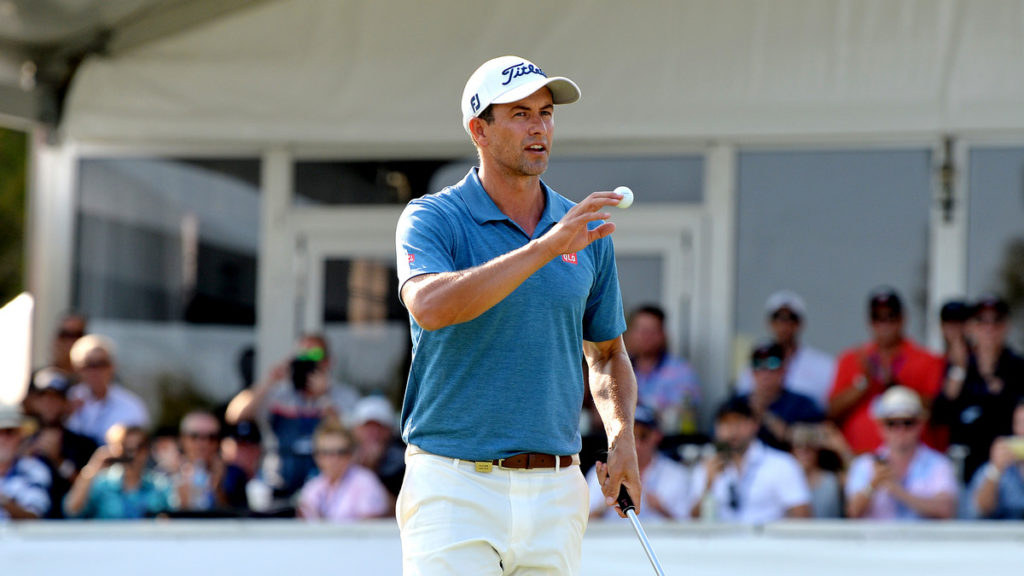
“It's incredibly bunched, and if it's windy tomorrow, it's going to be hard for anyone to really separate themselves unless they just play an incredible round of golf, go out there and roll in a lot of putts. For me, my strategy's going to be the same. Unless I hole a lot of long putts, I don't see myself just running away with this thing. I'm in for a fight tomorrow.
“I've tried really hard to keep my intensity up after last week, and my focus on the course. I've had a couple moments where I've wavered, but I've managed to pull it back together. It would be nice to cap off this year with a win here at home because I know what the confidence of that can do going into next year and just kind of make things a little more comfortable running into the Masters time.”
The 2013 Masters Champion, who also won this event that same year, carded a three under par round of 69 to move to ten under par, one clear of fellow South Australian Wade Ormsby. The pair, both from the city of Adelaide, grew up playing junior golf against each other. Ormsby carded a two under par round of 70 to reach nine under par on the Gold Coast.
Your 54 hole leader ✍️@AdamScott #AUSPGA pic.twitter.com/qsVxp4vFWn
— The European Tour (@EuropeanTour) December 21, 2019
“I put myself in perfect position going into Sunday. It's tricky out there with the wind and some of the pin positions. Everything's getting firmer. I'm not sure how those boys shot their scores this morning, but you just have to hang in there.
“It's hard to kind of get out in front and go, but I guess any course, if you hit enough good shots and hole enough putts, you can get going. I think you need to putt well in order to do that, but you've still got to play the golf course on its merits. There's going to be some tricky flags tomorrow and there'll be some gettable ones, so I'll just keep plodding my way around and play the same type of golf I've been playing and see where that leaves me.”
Scott, who represented the International side at last week's Presidents Cup, and Ormsby, who is searching for his second European Tour title, faced-off in a play-off at this event in 2014, but both lost out to Greg Chalmers, who won his second Australian PGA Championship title after a marathon seven extra holes.
Australian Nick Flanagan flew up the leaderboard on moving day, making the most of benign conditions in the morning to card a course record-equalling nine under par round of 63 to move into third place on eight under par. He is joined on that number by compatriot Min Woo Lee, New Zealander Michael Hendry and Carl Yuan, of China.
“I would give my game probably eight out of ten today," said Lee. "There were a few mistakes, but I held in there and hit very good shots, probably one of the best ball striking rounds I had all year. It was nice to back that up and hopefully there's one more tomorrow.
“The thing about golf is the one week where you don't make mistakes, you're probably going to be up there in the lead or going to win - I'm still looking for that. Hopefully, it's this week. But I'm still learning a lot about myself. There's a lot of wind out here, every shot counts. Hopefully I can learn from everything I do every week.”
Ayer en el hoyo 15 estaba fuera del torneo...golf, gran deporte.
— Alejandro Cañizares (@Acanizares10) December 21, 2019
Yesterday on the 15th tee I was out of the tournament...things can change in this great sport we try to play #Auspga @europeantour pic.twitter.com/PaAP9a2Uh8
Spaniard Alejandro Cañizares, who teed off in the first group on Saturday morning, carded an eight under par round of 64 to move into a share of seventh place on seven under with Australian Nick Cullan.
“All week I felt like I was hitting the ball well, I just wasn't scoring in the beginning," said Cañizares. "Yesterday I went double (bogey) and then bogey and I was four over with four to go – I said ‘let's try and make four birdies to come in'. I made three birdies on the last four and made the cut on the number with a birdie on the last.
“Today was one of those days where there was no wind, I was first off and the golf course was perfect and I started hitting great shots with my irons. It was one of those days that I was putting well and hitting good shots, I thought I could get up there and keep it going. It was a shame having a couple of bogeys, I had a bad tee shot on the par five, but then I had two birdies to fix it.”
In ninth are a trio of European Tour members, Aaron Cockerill, of Canada, South African Bryce Easton and Frenchman Romain Wattel.
Defending champion Cameron Smith, seeking an historic third consecutive Australian PGA Championship will start the final round five shots back on five under par, in a share of 12 th place.
Pos. |
Player | Nat |
To Par |
R1 |
R2 |
R3 |
Total |
1 |
Adam Scott | AUS |
-10 |
70 |
67 |
69 |
206 |
2 |
Wade Ormsby | AUS |
-9 |
68 |
69 |
70 |
207 |
T3 |
Nick Flanagan | AUS |
-8 |
72 |
73 |
63 |
208 |
T3 |
Min-Woo Lee | AUS |
-8 |
68 |
72 |
68 |
208 |
T3 |
Michael Hendry | NZL |
-8 |
70 |
68 |
70 |
208 |
T3 |
Carl Yuan | CHN |
-8 |
70 |
65 |
73 |
208 |
T7 |
Alejandro Canizares | ESP |
-7 |
73 |
72 |
64 |
209 |
T7 |
Nick Cullen | AUS |
-7 |
68 |
73 |
68 |
209 |
T9 |
Romain Wattel | FRA |
-6 |
73 |
70 |
67 |
210 |
T9 |
Aaron Cockerill | CAN |
-6 |
70 |
71 |
69 |
210 |
T9 |
Bryce Easton | RSA |
-6 |
71 |
68 |
71 |
210 |
T12 |
Greg Chalmers | AUS |
-5 |
74 |
69 |
68 |
211 |
T12 |
Brady Watt | AUS |
-5 |
72 |
70 |
69 |
211 |
T12 |
Cameron Davis | AUS |
-5 |
72 |
70 |
69 |
211 |
T12 |
Andrew Dodt | AUS |
-5 |
69 |
72 |
70 |
211 |
T12 |
Cameron Smith | AUS |
-5 |
74 |
65 |
72 |
211 |
T12 |
Anthony Quayle | AUS |
-5 |
70 |
66 |
75 |
211 |
T18 |
Jamie Arnold | AUS |
-4 |
73 |
72 |
67 |
212 |
T18 |
Simon Hawkes | AUS |
-4 |
72 |
70 |
70 |
212 |
T18 |
Cameron Champ | USA |
-4 |
71 |
70 |
71 |
212 |
T18 |
Brett Rankin | AUS |
-4 |
67 |
73 |
72 |
212 |
T18 |
Travis Smyth | AUS |
-4 |
68 |
72 |
72 |
212 |
T23 |
Denzel Ieremia | NZL |
-3 |
77 |
67 |
69 |
213 |
T23 |
Daniel Gale | AUS |
-3 |
72 |
71 |
70 |
213 |
T23 |
Min-Kyu Kim | KOR |
-3 |
72 |
69 |
72 |
213 |
T23 |
Stewart Cink | USA |
-3 |
70 |
72 |
71 |
213 |
T23 |
Brett Rumford | AUS |
-3 |
72 |
69 |
72 |
213 |
T23 |
Steven Jeffress | AUS |
-3 |
71 |
70 |
72 |
213 |
T23 |
Ryan Fox | NZL |
-3 |
69 |
72 |
72 |
213 |
T23 |
Tom Power-Horan | AUS |
-3 |
72 |
66 |
75 |
213 |
T31 |
Steve Allan | AUS |
-2 |
70 |
75 |
69 |
214 |
T31 |
Matthew Stieger | AUS |
-2 |
74 |
70 |
70 |
214 |
T31 |
Jack Senior | ENG |
-2 |
70 |
74 |
70 |
214 |
T31 |
Brad Kennedy | AUS |
-2 |
71 |
72 |
71 |
214 |
T31 |
Johannes Veerman | USA |
-2 |
70 |
71 |
73 |
214 |
T36 |
Maverick Antcliff | AUS |
-1 |
73 |
71 |
71 |
215 |
T36 |
Damien Perrier | FRA |
-1 |
70 |
72 |
73 |
215 |
T36 |
Josh Geary | NZL |
-1 |
73 |
69 |
73 |
215 |
T36 |
Blake Windred | AUS |
-1 |
72 |
70 |
73 |
215 |
T36 |
Harry Bateman | NZL |
-1 |
69 |
71 |
75 |
215 |
T41 |
Daniel Hillier | NZL |
Par |
74 |
71 |
71 |
216 |
T41 |
Troy Moses | AUS |
Par |
75 |
68 |
73 |
216 |
T41 |
Nick Voke | NZL |
Par |
69 |
71 |
76 |
216 |
T41 |
Rhein Gibson | AUS |
Par |
71 |
69 |
76 |
216 |
T45 |
Ashley Hall | AUS |
1 |
72 |
73 |
72 |
217 |
T45 |
Janne Kaske | FIN |
1 |
74 |
71 |
72 |
217 |
T45 |
Michael Wright | AUS |
1 |
69 |
75 |
73 |
217 |
T45 |
Mark R. Brown | AUS |
1 |
72 |
71 |
74 |
217 |
T45 |
Ryan Chisnall | NZL |
1 |
68 |
72 |
77 |
217 |
T45 |
Mikumu Horikawa | JPN |
1 |
72 |
68 |
77 |
217 |
T51 |
Louis De Jager | RSA |
2 |
74 |
71 |
73 |
218 |
T51 |
Sami Vaelimaeki | FIN |
2 |
72 |
73 |
73 |
218 |
T51 |
Zach Murray | AUS |
2 |
71 |
73 |
74 |
218 |
T51 |
Michael Sim | AUS |
2 |
73 |
70 |
75 |
218 |
T51 |
Rod Pampling | AUS |
2 |
70 |
73 |
75 |
218 |
T51 |
Calum Hill | SCO |
2 |
70 |
72 |
76 |
218 |
T57 |
Daniel Nisbet | AUS |
3 |
73 |
72 |
74 |
219 |
T57 |
Daniel Pearce | NZL |
3 |
72 |
72 |
75 |
219 |
T57 |
Taylor MacDonald | FJI |
3 |
73 |
71 |
75 |
219 |
T57 |
James Anstiss | NZL |
3 |
76 |
68 |
75 |
219 |
T61 |
Dylan Perry | AUS |
4 |
73 |
72 |
75 |
220 |
T61 |
Ross McGowan | ENG |
4 |
73 |
72 |
75 |
220 |
T61 |
Terry Pilkadaris | AUS |
4 |
70 |
75 |
75 |
220 |
T61 |
Harrison Endycott | AUS |
4 |
73 |
72 |
75 |
220 |
T61 |
Peter Fowler | AUS |
4 |
72 |
72 |
76 |
220 |
T61 |
Richard Green | AUS |
4 |
71 |
73 |
76 |
220 |
T61 |
Jason Norris | AUS |
4 |
69 |
75 |
76 |
220 |
T68 |
Dale Whitnell | ENG |
5 |
71 |
73 |
77 |
221 |
T68 |
Pedro Figueiredo | POR |
5 |
72 |
72 |
77 |
221 |
T70 |
Dimitrios Papadatos | AUS |
6 |
72 |
73 |
77 |
222 |
T70 |
Lucas Herbert | AUS |
6 |
67 |
77 |
78 |
222 |
72 |
Fraser MacLachlan | NZL |
10 |
72 |
72 |
82 |
226 |
CUT |
Andrew Evans | AUS |
2 |
74 |
72 |
- |
146 |
CUT |
Andrew Martin | AUS |
2 |
74 |
72 |
- |
146 |
CUT |
Christopher Wood | AUS |
2 |
75 |
71 |
- |
146 |
CUT |
David Coupland | ENG |
2 |
72 |
74 |
- |
146 |
CUT |
Deyen Lawson | AUS |
2 |
75 |
71 |
- |
146 |
CUT |
Gavin Fairfax | AUS |
2 |
71 |
75 |
- |
146 |
CUT |
Hurly Long | GER |
2 |
74 |
72 |
- |
146 |
CUT |
John Senden | AUS |
2 |
73 |
73 |
- |
146 |
CUT |
Justin Warren | AUS |
2 |
71 |
75 |
- |
146 |
CUT |
Kade McBride | AUS |
2 |
70 |
76 |
- |
146 |
CUT |
Nicolai Hoejgaard | DEN |
2 |
72 |
74 |
- |
146 |
CUT |
Samuel Eaves | AUS |
2 |
70 |
76 |
- |
146 |
CUT |
Chase Hanna | USA |
3 |
73 |
74 |
- |
147 |
CUT |
Daniel Gavins | ENG |
3 |
76 |
71 |
- |
147 |
CUT |
David Smail | NZL |
3 |
69 |
78 |
- |
147 |
CUT |
Gary Stal | FRA |
3 |
76 |
71 |
- |
147 |
CUT |
James Marchesani | AUS |
3 |
72 |
75 |
- |
147 |
CUT |
Jeong-Woo Ham | KOR |
3 |
73 |
74 |
- |
147 |
CUT |
Jordan Mullaney | AUS |
3 |
70 |
77 |
- |
147 |
CUT |
Marcus Fraser | AUS |
3 |
73 |
74 |
- |
147 |
CUT |
Matt Jager | AUS |
3 |
75 |
72 |
- |
147 |
CUT |
Nathan Green | AUS |
3 |
73 |
74 |
- |
147 |
CUT |
Peter Lonard | AUS |
3 |
73 |
74 |
- |
147 |
CUT |
Scott Strange | AUS |
3 |
75 |
72 |
- |
147 |
CUT |
Smylie Kaufman | USA |
3 |
73 |
74 |
- |
147 |
CUT |
Tim Stewart | AUS |
3 |
72 |
75 |
- |
147 |
CUT |
Toby Tree | ENG |
3 |
73 |
74 |
- |
147 |
CUT |
Adam Bland | AUS |
4 |
73 |
75 |
- |
148 |
CUT |
Ben Eccles | AUS |
4 |
71 |
77 |
- |
148 |
CUT |
Blake Proverbs | AUS |
4 |
80 |
68 |
- |
148 |
CUT |
Daniel Young | SCO |
4 |
74 |
74 |
- |
148 |
CUT |
James Nitties | AUS |
4 |
75 |
73 |
- |
148 |
CUT |
Lincoln Tighe | AUS |
4 |
73 |
75 |
- |
148 |
CUT |
Matthew Griffin | AUS |
4 |
75 |
73 |
- |
148 |
CUT |
Peter Cooke | RSA |
4 |
76 |
72 |
- |
148 |
CUT |
Robin Petersson | SWE |
4 |
76 |
72 |
- |
148 |
CUT |
Sam Brazel | AUS |
4 |
71 |
77 |
- |
148 |
CUT |
Aaron Zemmer | ITA |
5 |
74 |
75 |
- |
149 |
CUT |
Cory Crawford | AUS |
5 |
76 |
73 |
- |
149 |
CUT |
Jack Wilson | AUS |
5 |
72 |
77 |
- |
149 |
CUT |
Jake McLeod | AUS |
5 |
72 |
77 |
- |
149 |
CUT |
Peter O'Malley | AUS |
5 |
78 |
71 |
- |
149 |
CUT |
Rick Kulacz | AUS |
5 |
75 |
74 |
- |
149 |
CUT |
Adam Burdett | AUS |
6 |
74 |
76 |
- |
150 |
CUT |
Blake Collyer | AUS |
6 |
76 |
74 |
- |
150 |
CUT |
Callan O'Reilly | AUS |
6 |
72 |
78 |
- |
150 |
CUT |
Campbell Rawson | NZL |
6 |
76 |
74 |
- |
150 |
CUT |
Clement Sordet | FRA |
6 |
74 |
76 |
- |
150 |
CUT |
Damien Jordan | AUS |
6 |
77 |
73 |
- |
150 |
CUT |
David Bransdon | AUS |
6 |
75 |
75 |
- |
150 |
CUT |
David Howell | ENG |
6 |
75 |
75 |
- |
150 |
CUT |
David Micheluzzi | AUS |
6 |
74 |
76 |
- |
150 |
CUT |
Hyung-Seok Seo | KOR |
6 |
75 |
75 |
- |
150 |
CUT |
Jarryd Felton | AUS |
6 |
75 |
75 |
- |
150 |
CUT |
Jesper Sandborg | NZL |
6 |
79 |
71 |
- |
150 |
CUT |
Max McCardle | AUS |
6 |
76 |
74 |
- |
150 |
CUT |
Nick O'Hern | AUS |
6 |
77 |
73 |
- |
150 |
CUT |
Aaron Pike | AUS |
7 |
77 |
74 |
- |
151 |
CUT |
Cameron John | AUS |
7 |
74 |
77 |
- |
151 |
CUT |
Michael Long | NZL |
7 |
76 |
75 |
- |
151 |
CUT |
Peter Wilson | AUS |
7 |
76 |
75 |
- |
151 |
CUT |
Shae Wools-Cobb | AUS |
7 |
75 |
76 |
- |
151 |
CUT |
Brody Martin | AUS |
8 |
76 |
76 |
- |
152 |
CUT |
Dale Brandt-Richards | AUS |
8 |
77 |
75 |
- |
152 |
CUT |
Marcus Armitage | ENG |
8 |
74 |
78 |
- |
152 |
CUT |
David McKenzie | AUS |
9 |
77 |
76 |
- |
153 |
CUT |
Gareth Paddison | NZL |
9 |
76 |
77 |
- |
153 |
CUT |
Steven Bowditch | AUS |
9 |
79 |
74 |
- |
153 |
CUT |
Aaron Townsend | AUS |
10 |
79 |
75 |
- |
154 |
CUT |
Darren Beck | AUS |
10 |
78 |
76 |
- |
154 |
CUT |
Hugo Leon | CHI |
10 |
74 |
80 |
- |
154 |
CUT |
Peter Senior | AUS |
10 |
77 |
77 |
- |
154 |
CUT |
Vernon Sexton-Finck | AUS |
10 |
75 |
79 |
- |
154 |
CUT |
Braden Becker | AUS |
11 |
75 |
80 |
- |
155 |
CUT |
Jake Higginbottom | AUS |
11 |
77 |
78 |
- |
155 |
CUT |
Scott Laycock | AUS |
11 |
78 |
77 |
- |
155 |
CUT |
Brad Burns | AUS |
13 |
77 |
80 |
- |
157 |
CUT |
Zihao Chen | CHN |
13 |
78 |
79 |
- |
157 |
CUT |
Andrew Campbell | AUS |
14 |
82 |
76 |
- |
158 |
CUT |
Antonio Murdaca | AUS |
14 |
74 |
84 |
- |
158 |
CUT |
Robert Allenby | AUS |
15 |
85 |
74 |
- |
159 |
RET |
Jason Scrivener | AUS |
Par |
75 |
- |
- |
75 |
RET |
Matthew Millar | AUS |
Par |
77 |
- |
- |
77 |
RET |
Sebastian Garcia | ESP |
Par |
77 |
- |
- |
77 |
The European eTour, golf’s first esports series launched last week by the European Tour in partnership with DreamHack and TopGolf, has already received in excess of 45,000 entries from 169 countries across the globe.

In its first week, more than 45,000 unique users had signed up for the first qualifying round of the European eTour, playing a cumulative total of more than 200,000 rounds.
A total of 128 players carded scores of 60 or below, with all 128 qualifying for the next stage – which will be a bracket-style knockout competition played on WGT.com and the WGT Golf app, in the difficult conditions setting over Merion Golf Club and Chambers Bay Golf Club.
Those players who progress from the bracket rounds will take part in the first live eTour tournament at the Abu Dhabi HSBC Championship on Friday January 17, which is one of the six live events to be held at European Tour tournaments around the world.
Open qualifications for the European eTour are now open, but not for long. Sign up now for a chance to win $100,000 and fly around the world. #Golf meets #Gaming #esports
— European eTour (@etour_gg) December 16, 2019
Qualify here: https://t.co/yeyD2yloPP pic.twitter.com/G1c0lk5vf1
The five tournament winners, along with three wildcards qualifiers, will then contest the grand finale at the European Tour’s season-ending DP World Tour Championship, Dubai, which takes place at Jumeirah Golf Estates from November 19-22, 2020.
Rufus Hack, the European Tour’s Chief Content Officer, said: “We were very excited to launch our partnership with DreamHack and TopGolf last Friday given eSports is a market with such huge growth potential, but even we have been blown away by its early success and the number of sign-ups in just under a week.
“To have more than 45,000 people engage with the European Tour in such an interactive way is a measure of the myriad opportunities eSports provides for our brand – and that of our partners and sponsors. We believe this is just the beginning of an exciting journey as we continue in our quest to be market leaders in the field of sports innovation.”
Peter Norrelund, CEO Dreamhack Sport Games, said: “It is great to see so many participants in the first qualification for the European eTour. We are looking forward to have the eight players present at the first live eTour event in Abu Dhabi in January, where we will live broadcast all the action until the first winner on the European eTour is found", Peter Nørrelund, CEO Dreamhack Sport Games.
Topgolf Media President YuChiang Cheng: “Topgolf is proud of WGT’s ability to not only be the leading golf platform for online competition, but also to be part of the first-ever European eTour together with the European Tour and DreamHack. We’re thrilled with the response so far from players around the globe, and the tournament engagement only strengthens our belief in the power of connecting people through shared experiences.” The esports industry is one of the fastest growing media sectors with an audience of more than 380 million enthusiasts worldwide which is forecasted to surpass 1.6 billion by 2022. A majority of esports fans are in the 18-34 age demographic.
Try this hands-on (and thumbs-off!) drill to get a real sense of the way encouraging ‘lag’ in your swing unlocks your potential for generating clubhead speed. - Nick Bradley
If you could distil the ingredients of great ball striking with an iron in your hand it would probably come down to two elements; lag and speed. You see, lag has the ability to produce a great angle of attack with an iron, complimented by the added bonus of increased clubhead speed. Hands up who doesn’t want to hit it better and hit it farther?
Lag is often a mystical concept in golf – many golfers have tried to create ‘lag’ or a ‘late hit’ position only to find themselves even slower through the ball than before. Lag is not a static position, in fact it’s probably the least static and slow position we can have during the swing due to its dynamic forces. The moment you try to replace ‘motion’ with ‘position’ you generally kill speed! Lag is nothing more than the increasing of the club’s swingweight through angular momentum. That sounds like a mouthful but essentially all this means is the wrists cock or flex a little more during the downswing due to the pulling weight of the club. All we do to lag the club is to allow this sense of ‘heaviness’ to happen through the pliability of the wrists – yes they must feel soft and receptive to a dynamic change of direction in which the club feels really heavy.
This drill is going to give you that sense of weight, change of direction and speed.

The way to get this message through is to first take your regular grip; you are then going to lift both thumb pads off of the grip just as you see in this close-up picture. As you do this you will immediately gain a sense of the handle of the club increasing its weight into the fingers (which is why you should grip the handle there – i.e. low in the fingers – to begin with!). Take the time to get used to this dense heaviness, a feeling I doubt you would ever of had if you have been guilty of casting the club. Let the grip end bounce a little in your fingers as if somebody had asked you, ‘How much do you think that weighs?’ Only now will you begin to create the right feelings.
The trick to this is plenty of practice swings and rehearsals! Start to make a backswing but keep the thumb pads off of the grip handle until you reach the top of your swing and initiate the change of direction. When you sense your downswing has started let the handle of the club drop back onto the thumb pads; as this happens time and time again you will start to pick up on the rhythm and the physiology needed to create lag.
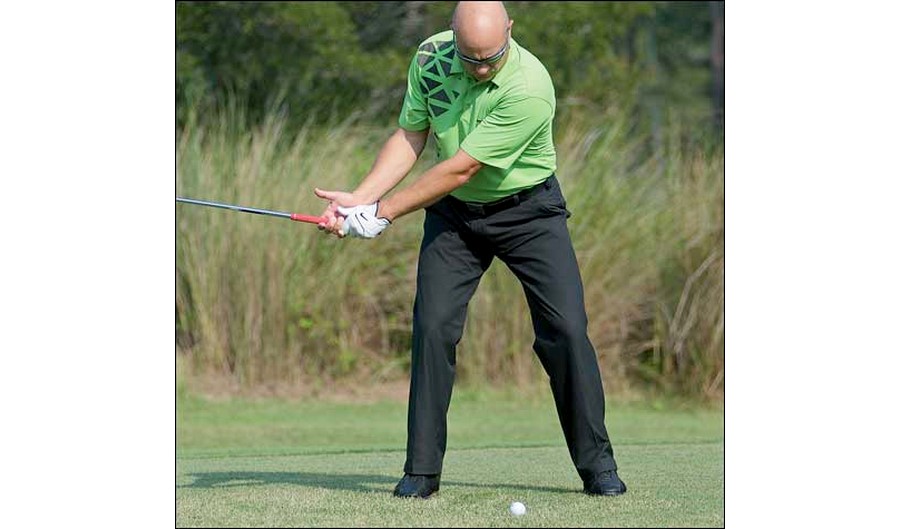
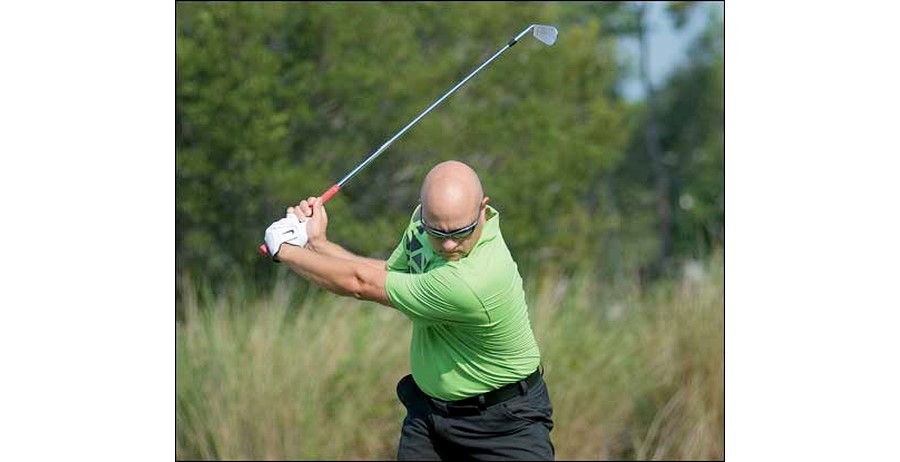
What do I mean by physiology? Any golfer I have ever seen in my 20-year career that has created little in the way of lag always demonstrated a tightness in the hands that severely altered the bodies ability to create lag and this extra angle into the ball. The most common example can be found with lady golfers who grip the club tightly to support its weight and motion but in doing so kill the swings ability to create leverage. The paradox is that if you want lag, speed and distance you have to ‘let go’ of control (CEO’s and CFO’s take note!) and give the club a little life of its own; let it bounce a little and have some motion! So, I want you doing this time and time again: ‘thumbs off…thumbs on’….. ’thumbs off….thumbs on’.
When you feel you have that down just clip a few half shots away trying to replicate that same softness the hands during the drill. you will be amazed at the pop the ball seems to now as it leaves the face. So, whenever there’s a lack of fizz from the ball and your strike pattern has become a little ‘uncompressed’ go back to ‘thumbs off, thumbs on’. In a short time you will enjoy that terrific feeling of natural lag in your swing and can focus on firing your iron shots start at your target.
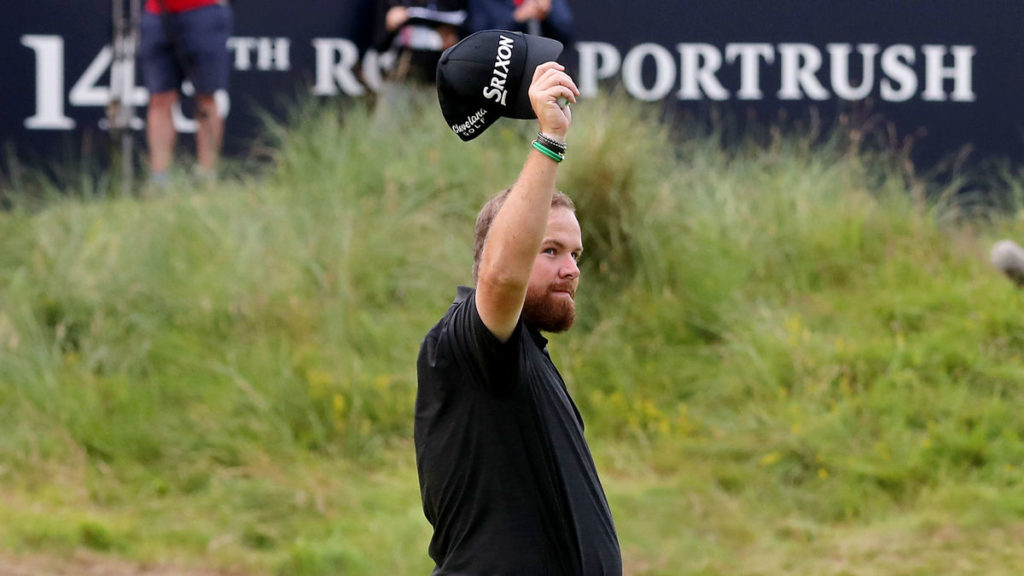
For Shane Lowry, the Open Championship at Royal Portrush this past summer brought memories that will never be forgotten, even if he may only have a hazy recall about some of the subsequent celebrations. With the Open being held in Ireland for only the second occasion ever, returning to Portrush for the first time since 1951, it could not have been more fitting that the champion golfer of the year (by a handsome six shots from Tommy Fleetwood) hailed from the Emerald Isle.
Perhaps the only way in which the story could have been improved from a romantic perspective would have been if the winner had come from Northern Ireland, where Portrush is located, which takes us from the good (Lowry) to the bad (Rory McIlroy).
On the opening hole of his opening round, the pre-tournament favourite hit a snap-hook off the tee. It went out-of-bounds, in part courtesy of a ricochet off a spectator’s mobile phone. McIlroy’s ‘three off the tee’ was only an improvement in that he could (just) play the ball. Another swipe was followed by a penalty shot; one more hack and two putts later he had his personal abominable snowman: an eight. The rest of his round was pretty poor and his fabulous fireworks on the Friday were not sufficient to enable him to make the cut.
Congratulations to @ShaneLowryGolf on winning the 2019 @AGWgolfwriters Golfer of the Year last night! 🇮🇪
— The Open (@TheOpen) December 16, 2019
Watch the full documentary 'The Clara Jug' for free here 👉 https://t.co/Vje2FWejIR 🎥 pic.twitter.com/28i35hSQx5
David Duval, the champion at Royal Lytham & St Annes in 2001, was another former winner to fail to make it through to the weekend. He delayed his first-round implosion a little longer than McIlroy, waiting until the 7th to run up a score of 14. At almost 600 yards it’s not an easy par-five but, still, to lose two balls off the tee and later play a wrong one does seem to have been over-egging it. Elsewhere Duval threw in a couple of triple-bogeys and a quadruple, all of which added up to a 91 (20 over par).
While McIlroy and Duval were undoubtedly errant with some of their play and duly paid the penalty, Kyle Stanley finished in a tie for 41st despite causing a greater threat to the paying public. Twice in the same round he hit spectators, which of course can happen, but what didn’t endear him to his playing partner, Robert MacIntyre, was that in both instances he didn’t yell “Fore!” Stanley protested that there were plenty of people around him doing just that, but MacIntyre wasn’t impressed. “There were harsh words spoken,” he said. “It wasn’t too pleasant but you’ve got to tell him it’s not right. You know from the word go that it’s going into the crowd. Just shout!”
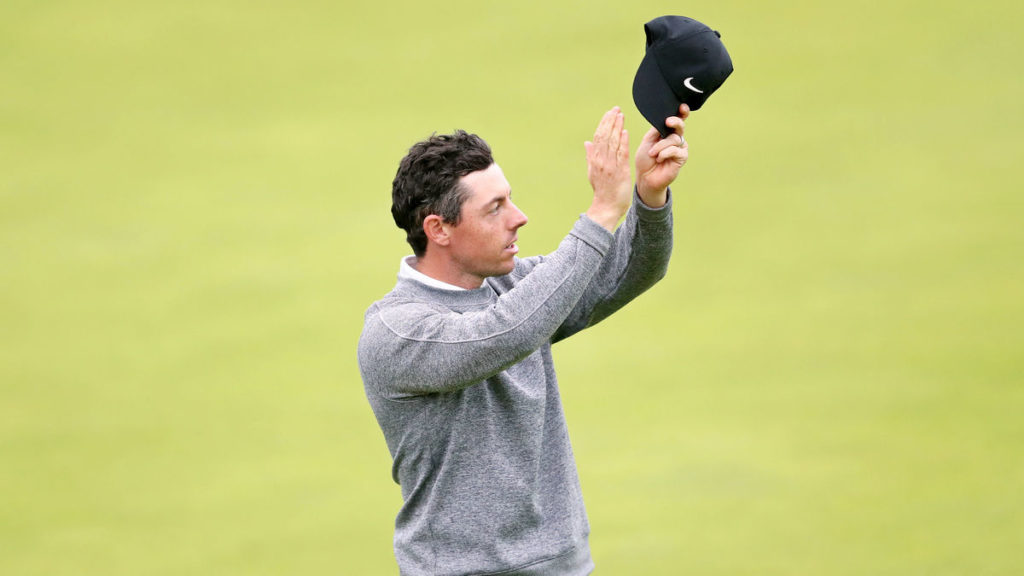
Many have shouted in vain about the glacial (non) pace of play of the dawdling J.B. Holmes. Nevertheless, in his own sweet time he had got to 10 under par after three rounds and went into the final day six shots behind the leader, Lowry. Victory was not out of the question. It pretty soon was, however. Holmes subsided with an 87 to plunge all the way down the leaderboard into a tie for 67th. Well, I say ‘plunge’: it would have seemed a little less urgent than that.
Happy Christmas and may all your rounds in 2020 be faster and better!
You can follow Robert Green on Twitter @robrtgreen and enjoy his other blog f-factors.com plus you can read more by him on golf at robertgreengolf.com
December 19-22
RACV Royal Pines Resort, Gold Coast, Queensland, Australia
AUD$1,500,000
Round 1, Round 3, Round 4
Major Champion Adam Scott carded a five under par round of 67 to stay in the hunt heading into the weekend at the Australian PGA Championship.
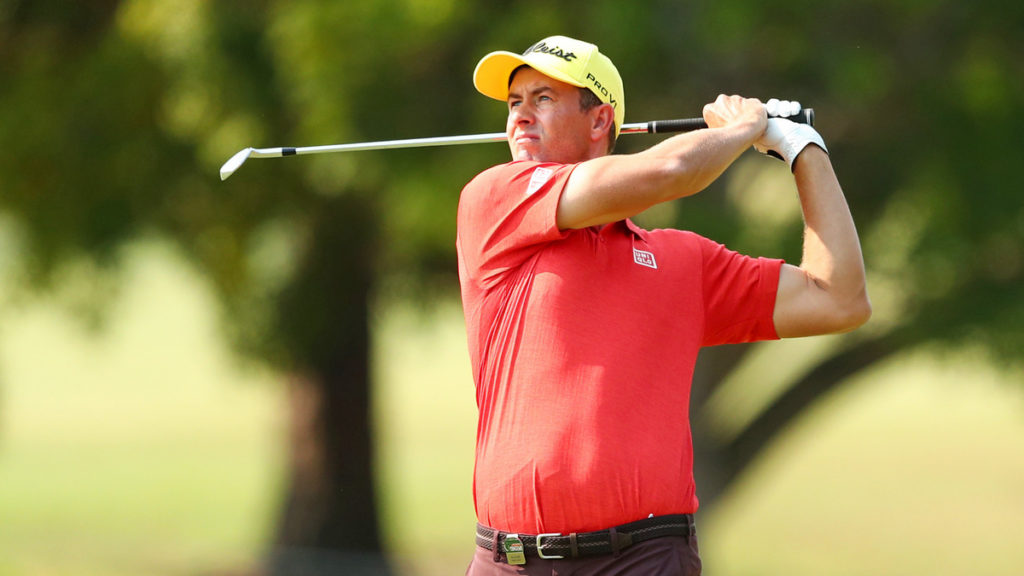
“It was a good solid round today, which I needed to kind of stay on the pace. Generally played really good today, so I'm pretty happy shooting 67. You should be most times you shoot 67.
“I pulled a seven iron somewhere that I didn't like very much and made a bogey, but other than that I think I pretty much hit 16 greens today, so it was fairly stress free. I played fairly defensive into the greens because I thought the pins were actually a little more tucked today and to get it really close you must risk hitting it down some of the big runoffs off these greens. I didn't really want to do that too much and I played safe. I rolled a lot of nice putts. A lot went by the edge, but I made a couple as well.”
Home favourite. Leader by one ✍️@AdamScott #AUSPGA pic.twitter.com/bpg8Q2EJhl
— The European Tour (@EuropeanTour) December 20, 2019
The home favourite, who became Australia's first Masters Champion in 2013, eagled the 15th hole at RACV Royal Pines Resort for the second day in a row, and then carded four further birdies to sit two strokes behind China's Carl Yuan. Yuan recorded the joint-low round of the tournament thus far, a seven under par 65, to move to nine under par.
“It was a great day, honestly," said Yuan. "I played great, played smart, stuck to the plan. I was fortunate enough that I got a couple of really long putts that dropped through the round. I made two little mistakes, but really pulled myself together and kept it going.
“It's my second time playing here. It was helpful playing here last year. I know the course a lot better and my strategy, the holes change a bit and it really paid off. I'm more used to the wind here now since I played here last year. It's a little different sometimes because change directions. Just got to really be patient and hit shot by shot here.”
In second is Australian Anthony Quayle, who plies his trade on the Japan Golf Tour. The 25-year-old moved to eight under par after a second round of 66, which included six birdies and an eagle.
The #AUSPGA three-peat is on 👀
— The European Tour (@EuropeanTour) December 20, 2019
Hear from @camsmithgolf after he played 9 shots better than yesterday 🎤 pic.twitter.com/MxXHhe7JMa
Scott shares third place with compatriot Wade Ormsby, who he grew up playing golf with in Adelaide, South Australia. The pair are one stroke ahead of Michael Hendry, of New Zealand, and Australia's Tom Power Horan.
“I think three of the last five years I've played well around here," said Ormsby. "It's a good course. Pretty tricky green complexes. I think if you have seen them a little bit and you know where to hit it, you've got a little bit of an advantage. You just can't hit darts all day, you've got to kind of play the golf course, play the pins and whatever else. I think that's probably the reason why I'm kind of around the mark this week.”
South African Bryce Easton, who finished 22nd on the Challenge Tour's Road to Mallorca Rankings in 2019, carded a four under par round of 68 to move to a share of seventh, alongside twice-defending champion Cameron Smith, who matched Yuan's round of 65.
Smith is bidding to become the first player to win a non-Major or WGC European Tour event three years in a row since Ernie Els won the Heineken Classic, also held in Australia, from 2002 to 2004.
Pos. |
Player | Nat |
To Par |
R1 |
R2 |
Total |
1 |
Carl Yuan | CHN |
-9 |
70 |
65 |
135 |
2 |
Anthony Quayle | AUS |
-8 |
70 |
66 |
136 |
T3 |
Adam Scott | AUS |
-7 |
70 |
67 |
137 |
T3 |
Wade Ormsby | AUS |
-7 |
68 |
69 |
137 |
T5 |
Michael Hendry | NZL |
-6 |
70 |
68 |
138 |
T5 |
Tom Power-Horan | AUS |
-6 |
72 |
66 |
138 |
T7 |
Bryce Easton | RSA |
-5 |
71 |
68 |
139 |
T7 |
Cameron Smith | AUS |
-5 |
74 |
65 |
139 |
T9 |
Min-Woo Lee | AUS |
-4 |
68 |
72 |
140 |
T9 |
Rhein Gibson | AUS |
-4 |
71 |
69 |
140 |
T9 |
Mikumu Horikawa | JPN |
-4 |
72 |
68 |
140 |
T9 |
Nick Voke | NZL |
-4 |
69 |
71 |
140 |
T9 |
Ryan Chisnall | NZL |
-4 |
68 |
72 |
140 |
T9 |
Travis Smyth | AUS |
-4 |
68 |
72 |
140 |
T9 |
Brett Rankin | AUS |
-4 |
67 |
73 |
140 |
T9 |
Harry Bateman | NZL |
-4 |
69 |
71 |
140 |
T17 |
Johannes Veerman | USA |
-3 |
70 |
71 |
141 |
T17 |
Cameron Champ | USA |
-3 |
71 |
70 |
141 |
T17 |
Ryan Fox | NZL |
-3 |
69 |
72 |
141 |
T17 |
Steven Jeffress | AUS |
-3 |
71 |
70 |
141 |
T17 |
Nick Cullen | AUS |
-3 |
68 |
73 |
141 |
T17 |
Andrew Dodt | AUS |
-3 |
69 |
72 |
141 |
T17 |
Aaron Cockerill | CAN |
-3 |
70 |
71 |
141 |
T17 |
Brett Rumford | AUS |
-3 |
72 |
69 |
141 |
T17 |
Min-Kyu Kim | KOR |
-3 |
72 |
69 |
141 |
T26 |
Stewart Cink | USA |
-2 |
70 |
72 |
142 |
T26 |
Calum Hill | SCO |
-2 |
70 |
72 |
142 |
T26 |
Blake Windred | AUS |
-2 |
72 |
70 |
142 |
T26 |
Brady Watt | AUS |
-2 |
72 |
70 |
142 |
T26 |
Cameron Davis | AUS |
-2 |
72 |
70 |
142 |
T26 |
Josh Geary | NZL |
-2 |
73 |
69 |
142 |
T26 |
Damien Perrier | FRA |
-2 |
70 |
72 |
142 |
T26 |
Simon Hawkes | AUS |
-2 |
72 |
70 |
142 |
T34 |
Daniel Gale | AUS |
-1 |
72 |
71 |
143 |
T34 |
Greg Chalmers | AUS |
-1 |
74 |
69 |
143 |
T34 |
Rod Pampling | AUS |
-1 |
70 |
73 |
143 |
T34 |
Michael Sim | AUS |
-1 |
73 |
70 |
143 |
T34 |
Troy Moses | AUS |
-1 |
75 |
68 |
143 |
T34 |
Brad Kennedy | AUS |
-1 |
71 |
72 |
143 |
T34 |
Mark R. Brown | AUS |
-1 |
72 |
71 |
143 |
T34 |
Romain Wattel | FRA |
-1 |
73 |
70 |
143 |
T42 |
Jason Norris | AUS |
Par |
69 |
75 |
144 |
T42 |
Jack Senior | ENG |
Par |
70 |
74 |
144 |
T42 |
Richard Green | AUS |
Par |
71 |
73 |
144 |
T42 |
Denzel Ieremia | NZL |
Par |
77 |
67 |
144 |
T42 |
Matthew Stieger | AUS |
Par |
74 |
70 |
144 |
T42 |
Pedro Figueiredo | POR |
Par |
72 |
72 |
144 |
T42 |
James Anstiss | NZL |
Par |
76 |
68 |
144 |
T42 |
Taylor MacDonald | FJI |
Par |
73 |
71 |
144 |
T42 |
Lucas Herbert | AUS |
Par |
67 |
77 |
144 |
T42 |
Dale Whitnell | ENG |
Par |
71 |
73 |
144 |
T42 |
Zach Murray | AUS |
Par |
71 |
73 |
144 |
T42 |
Peter Fowler | AUS |
Par |
72 |
72 |
144 |
T42 |
Maverick Antcliff | AUS |
Par |
73 |
71 |
144 |
T42 |
Michael Wright | AUS |
Par |
69 |
75 |
144 |
T42 |
Daniel Pearce | NZL |
Par |
72 |
72 |
144 |
T42 |
Fraser MacLachlan | NZL |
Par |
72 |
72 |
144 |
T58 |
Dimitrios Papadatos | AUS |
1 |
72 |
73 |
145 |
T58 |
Harrison Endycott | AUS |
1 |
73 |
72 |
145 |
T58 |
Sami Vaelimaeki | FIN |
1 |
72 |
73 |
145 |
T58 |
Terry Pilkadaris | AUS |
1 |
70 |
75 |
145 |
T58 |
Daniel Nisbet | AUS |
1 |
73 |
72 |
145 |
T58 |
Dylan Perry | AUS |
1 |
73 |
72 |
145 |
T58 |
Ross McGowan | ENG |
1 |
73 |
72 |
145 |
T58 |
Louis De Jager | RSA |
1 |
74 |
71 |
145 |
T58 |
Jamie Arnold | AUS |
1 |
73 |
72 |
145 |
T58 |
Janne Kaske | FIN |
1 |
74 |
71 |
145 |
T58 |
Daniel Hillier | NZL |
1 |
74 |
71 |
145 |
T58 |
Nick Flanagan | AUS |
1 |
72 |
73 |
145 |
T58 |
Alejandro Canizares | ESP |
1 |
73 |
72 |
145 |
T58 |
Steve Allan | AUS |
1 |
70 |
75 |
145 |
T58 |
Ashley Hall | AUS |
1 |
72 |
73 |
145 |
CUT |
Andrew Evans | AUS |
2 |
74 |
72 |
146 |
CUT |
Andrew Martin | AUS |
2 |
74 |
72 |
146 |
CUT |
Christopher Wood | AUS |
2 |
75 |
71 |
146 |
CUT |
David Coupland | ENG |
2 |
72 |
74 |
146 |
CUT |
Deyen Lawson | AUS |
2 |
75 |
71 |
146 |
CUT |
Gavin Fairfax | AUS |
2 |
71 |
75 |
146 |
CUT |
Hurly Long | GER |
2 |
74 |
72 |
146 |
CUT |
John Senden | AUS |
2 |
73 |
73 |
146 |
CUT |
Justin Warren | AUS |
2 |
71 |
75 |
146 |
CUT |
Kade McBride | AUS |
2 |
70 |
76 |
146 |
CUT |
Nicolai Hoejgaard | DEN |
2 |
72 |
74 |
146 |
CUT |
Samuel Eaves | AUS |
2 |
70 |
76 |
146 |
CUT |
Chase Hanna | USA |
3 |
73 |
74 |
147 |
CUT |
Daniel Gavins | ENG |
3 |
76 |
71 |
147 |
CUT |
David Smail | NZL |
3 |
69 |
78 |
147 |
CUT |
Gary Stal | FRA |
3 |
76 |
71 |
147 |
CUT |
James Marchesani | AUS |
3 |
72 |
75 |
147 |
CUT |
Jeong-Woo Ham | KOR |
3 |
73 |
74 |
147 |
CUT |
Jordan Mullaney | AUS |
3 |
70 |
77 |
147 |
CUT |
Marcus Fraser | AUS |
3 |
73 |
74 |
147 |
CUT |
Matt Jager | AUS |
3 |
75 |
72 |
147 |
CUT |
Nathan Green | AUS |
3 |
73 |
74 |
147 |
CUT |
Peter Lonard | AUS |
3 |
73 |
74 |
147 |
CUT |
Scott Strange | AUS |
3 |
75 |
72 |
147 |
CUT |
Smylie Kaufman | USA |
3 |
73 |
74 |
147 |
CUT |
Tim Stewart | AUS |
3 |
72 |
75 |
147 |
CUT |
Toby Tree | ENG |
3 |
73 |
74 |
147 |
CUT |
Adam Bland | AUS |
4 |
73 |
75 |
148 |
CUT |
Ben Eccles | AUS |
4 |
71 |
77 |
148 |
CUT |
Blake Proverbs | AUS |
4 |
80 |
68 |
148 |
CUT |
Daniel Young | SCO |
4 |
74 |
74 |
148 |
CUT |
James Nitties | AUS |
4 |
75 |
73 |
148 |
CUT |
Lincoln Tighe | AUS |
4 |
73 |
75 |
148 |
CUT |
Matthew Griffin | AUS |
4 |
75 |
73 |
148 |
CUT |
Peter Cooke | RSA |
4 |
76 |
72 |
148 |
CUT |
Robin Petersson | SWE |
4 |
76 |
72 |
148 |
CUT |
Sam Brazel | AUS |
4 |
71 |
77 |
148 |
CUT |
Aaron Zemmer | ITA |
5 |
74 |
75 |
149 |
CUT |
Cory Crawford | AUS |
5 |
76 |
73 |
149 |
CUT |
Jack Wilson | AUS |
5 |
72 |
77 |
149 |
CUT |
Jake McLeod | AUS |
5 |
72 |
77 |
149 |
CUT |
Peter O'Malley | AUS |
5 |
78 |
71 |
149 |
CUT |
Rick Kulacz | AUS |
5 |
75 |
74 |
149 |
CUT |
Adam Burdett | AUS |
6 |
74 |
76 |
150 |
CUT |
Blake Collyer | AUS |
6 |
76 |
74 |
150 |
CUT |
Callan O'Reilly | AUS |
6 |
72 |
78 |
150 |
CUT |
Campbell Rawson | NZL |
6 |
76 |
74 |
150 |
CUT |
Clement Sordet | FRA |
6 |
74 |
76 |
150 |
CUT |
Damien Jordan | AUS |
6 |
77 |
73 |
150 |
CUT |
David Bransdon | AUS |
6 |
75 |
75 |
150 |
CUT |
David Howell | ENG |
6 |
75 |
75 |
150 |
CUT |
David Micheluzzi | AUS |
6 |
74 |
76 |
150 |
CUT |
Hyung-Seok Seo | KOR |
6 |
75 |
75 |
150 |
CUT |
Jarryd Felton | AUS |
6 |
75 |
75 |
150 |
CUT |
Jesper Sandborg | NZL |
6 |
79 |
71 |
150 |
CUT |
Max McCardle | AUS |
6 |
76 |
74 |
150 |
CUT |
Nick O'Hern | AUS |
6 |
77 |
73 |
150 |
CUT |
Aaron Pike | AUS |
7 |
77 |
74 |
151 |
CUT |
Cameron John | AUS |
7 |
74 |
77 |
151 |
CUT |
Michael Long | NZL |
7 |
76 |
75 |
151 |
CUT |
Peter Wilson | AUS |
7 |
76 |
75 |
151 |
CUT |
Shae Wools-Cobb | AUS |
7 |
75 |
76 |
151 |
CUT |
Brody Martin | AUS |
8 |
76 |
76 |
152 |
CUT |
Dale Brandt-Richards | AUS |
8 |
77 |
75 |
152 |
CUT |
Marcus Armitage | ENG |
8 |
74 |
78 |
152 |
CUT |
David McKenzie | AUS |
9 |
77 |
76 |
153 |
CUT |
Gareth Paddison | NZL |
9 |
76 |
77 |
153 |
CUT |
Steven Bowditch | AUS |
9 |
79 |
74 |
153 |
CUT |
Aaron Townsend | AUS |
10 |
79 |
75 |
154 |
CUT |
Darren Beck | AUS |
10 |
78 |
76 |
154 |
CUT |
Hugo Leon | CHI |
10 |
74 |
80 |
154 |
CUT |
Peter Senior | AUS |
10 |
77 |
77 |
154 |
CUT |
Vernon Sexton-Finck | AUS |
10 |
75 |
79 |
154 |
CUT |
Braden Becker | AUS |
11 |
75 |
80 |
155 |
CUT |
Jake Higginbottom | AUS |
11 |
77 |
78 |
155 |
CUT |
Scott Laycock | AUS |
11 |
78 |
77 |
155 |
CUT |
Brad Burns | AUS |
13 |
77 |
80 |
157 |
CUT |
Zihao Chen | CHN |
13 |
78 |
79 |
157 |
CUT |
Andrew Campbell | AUS |
14 |
82 |
76 |
158 |
CUT |
Antonio Murdaca | AUS |
14 |
74 |
84 |
158 |
CUT |
Robert Allenby | AUS |
15 |
85 |
74 |
159 |
RET |
Jason Scrivener | AUS |
Par |
75 |
- |
75 |
RET |
Matthew Millar | AUS |
Par |
77 |
- |
77 |
RET |
Sebastian Garcia | ESP |
Par |
77 |
- |
77 |
